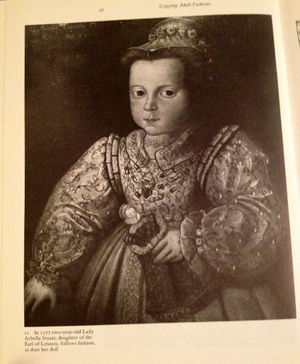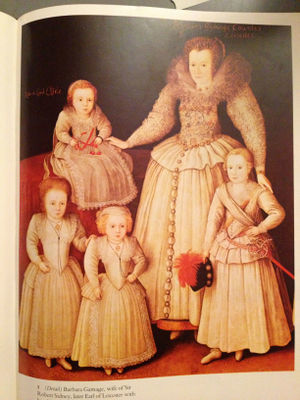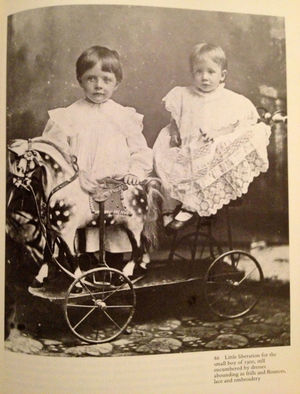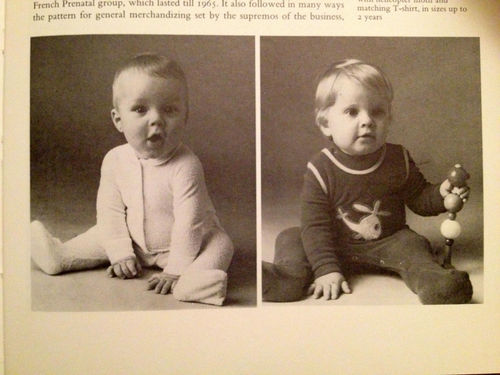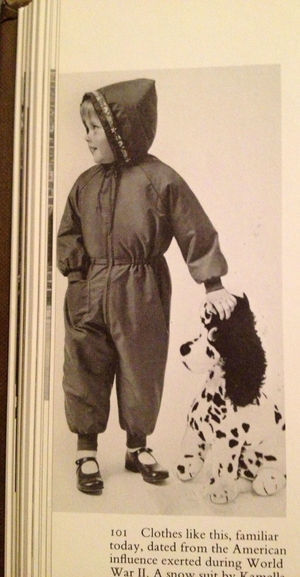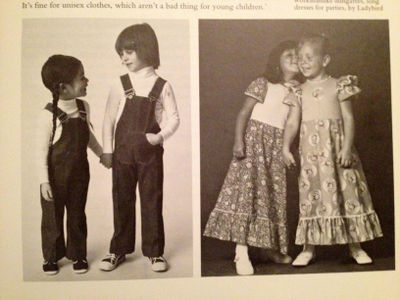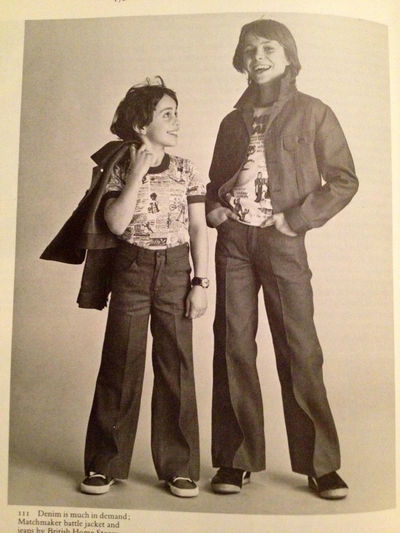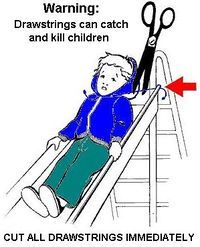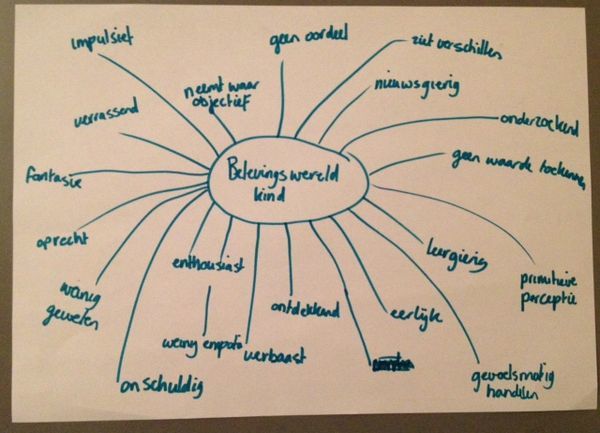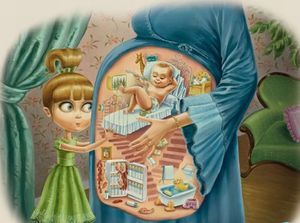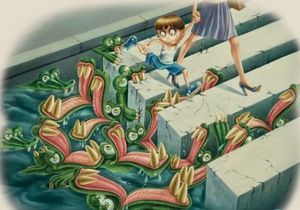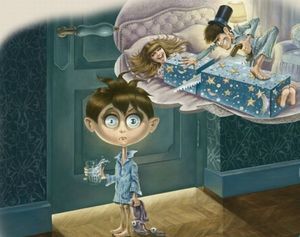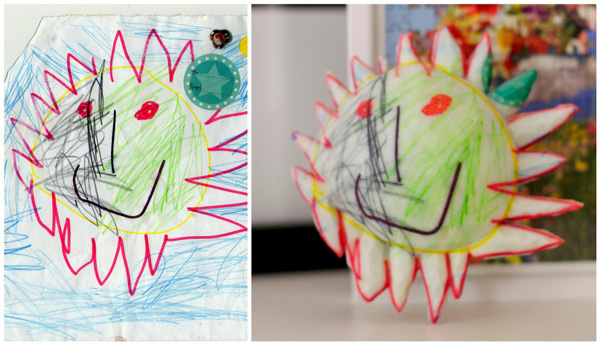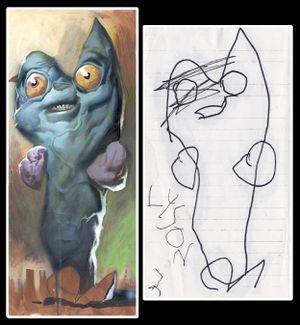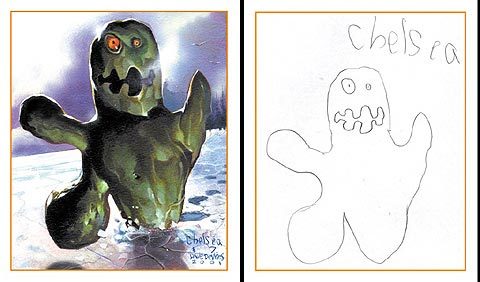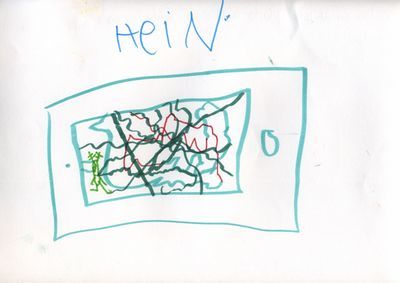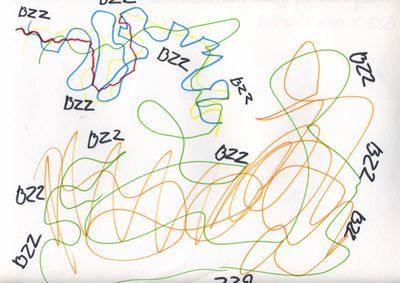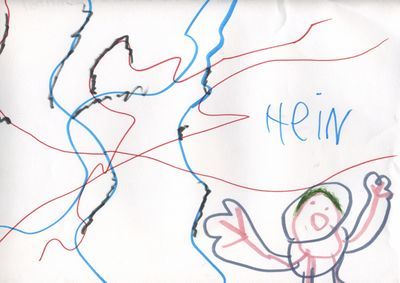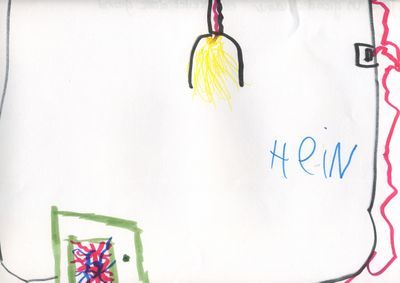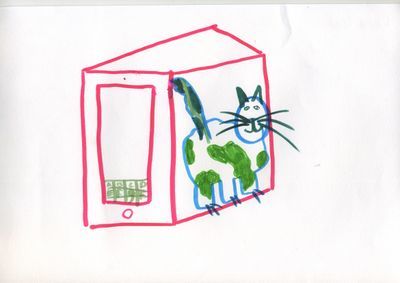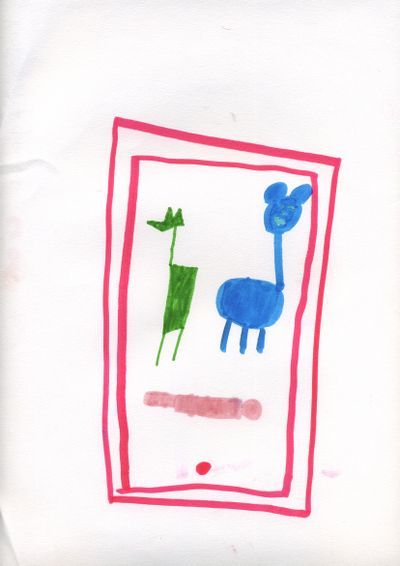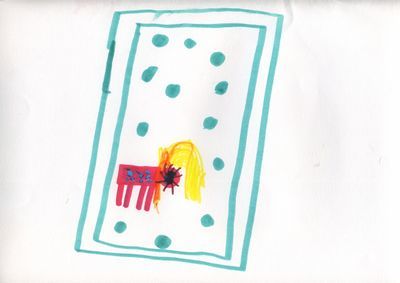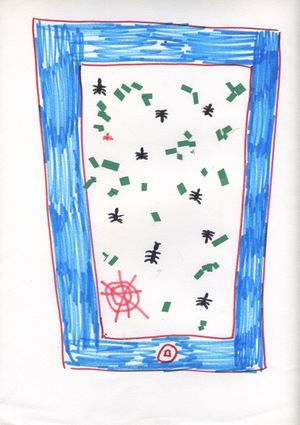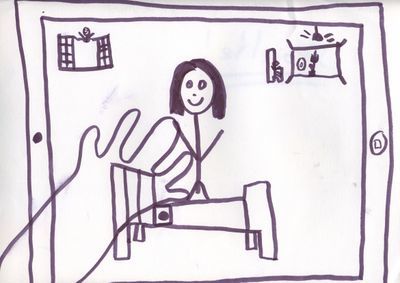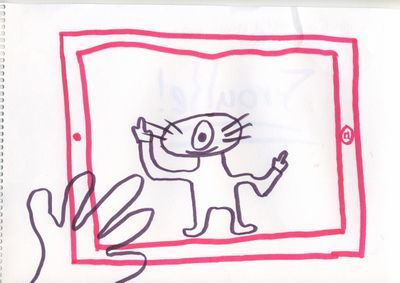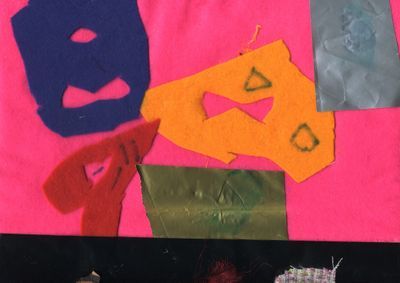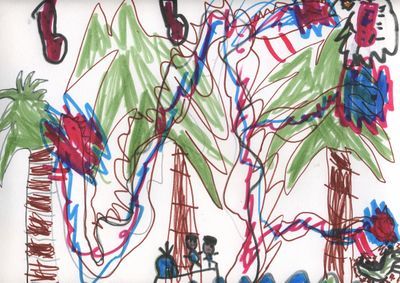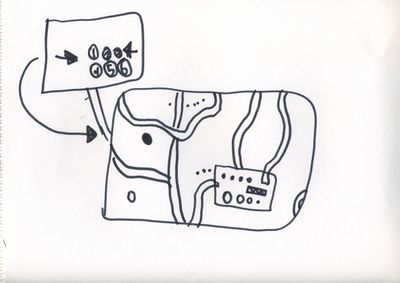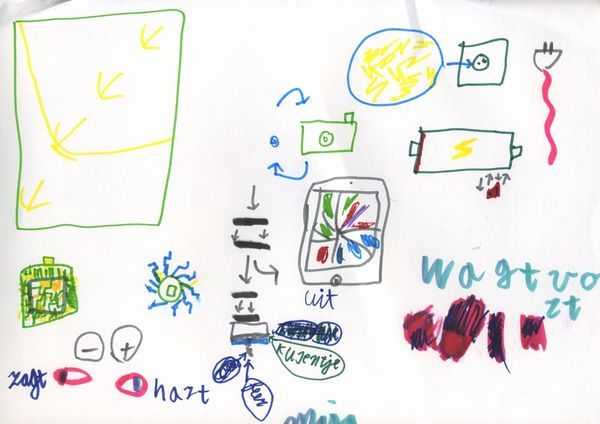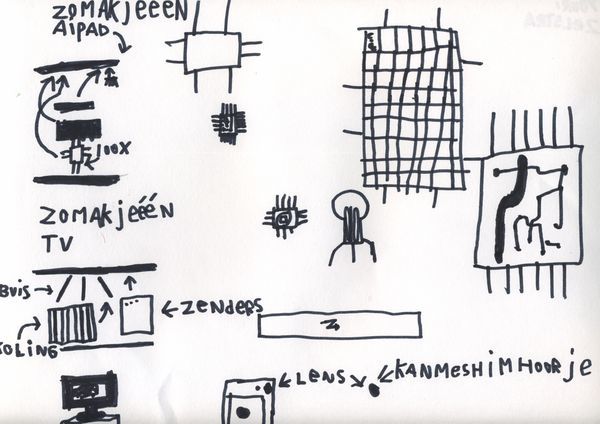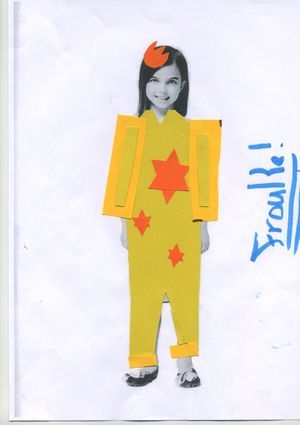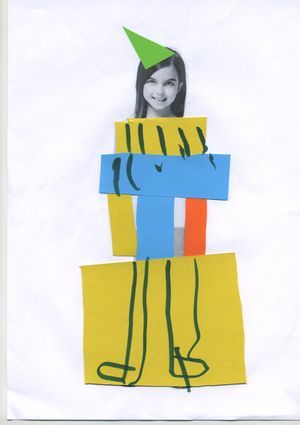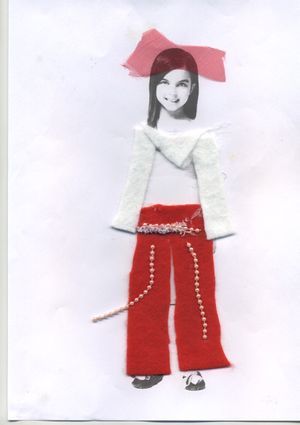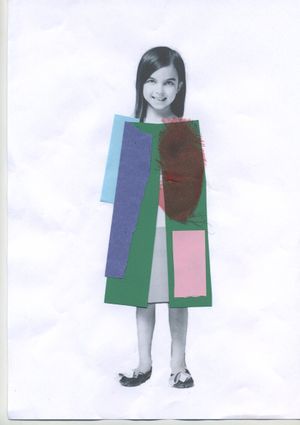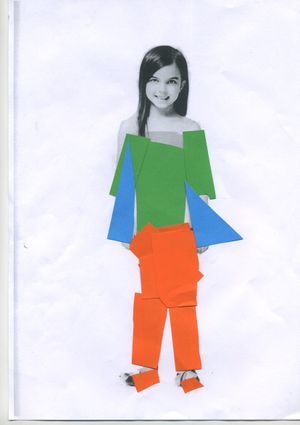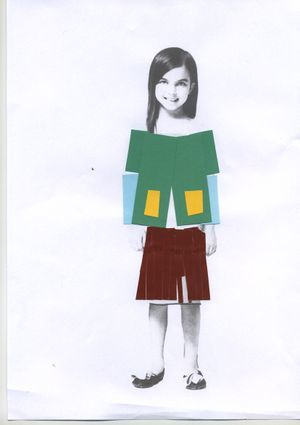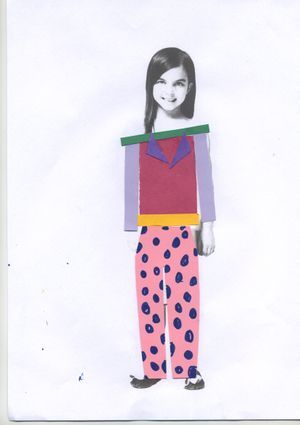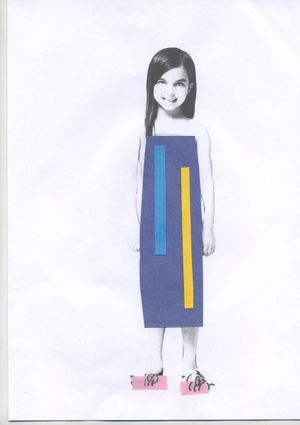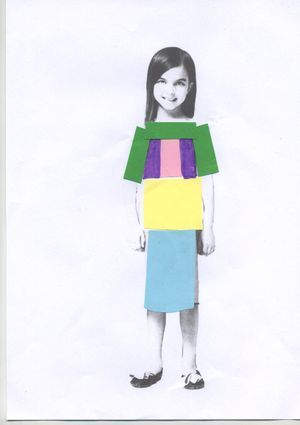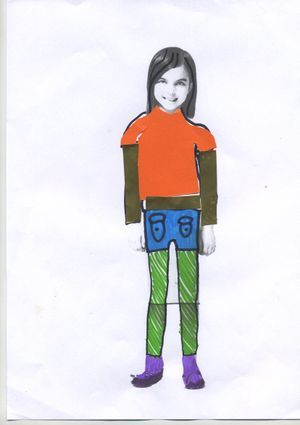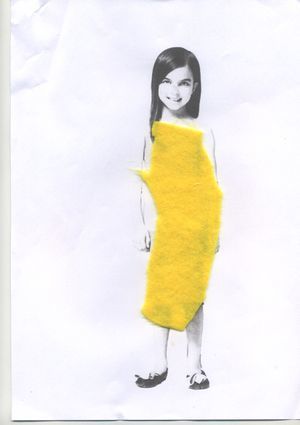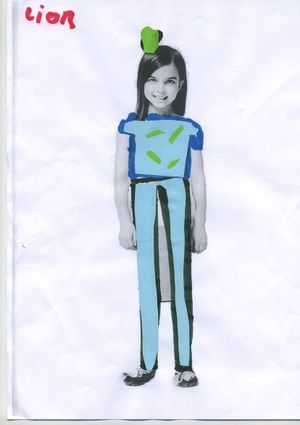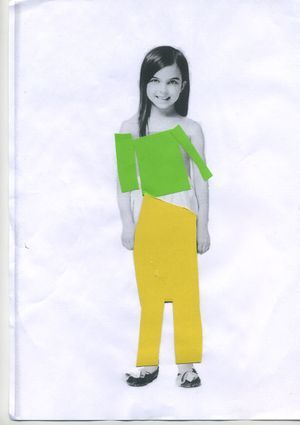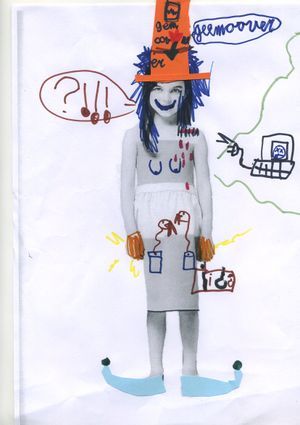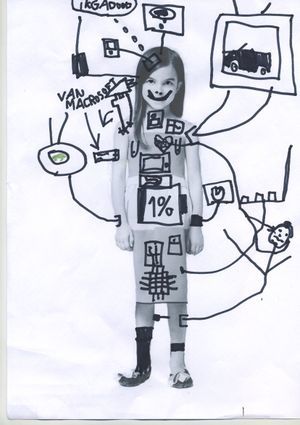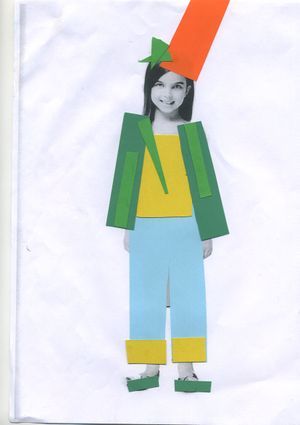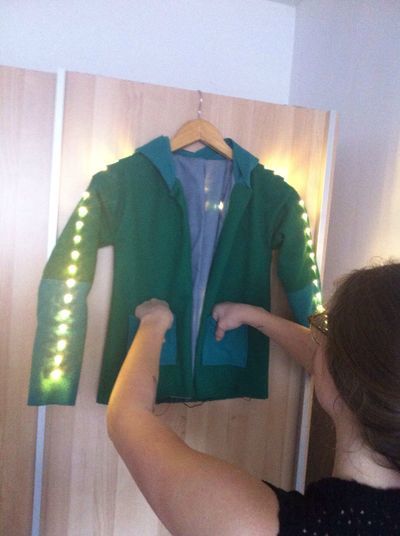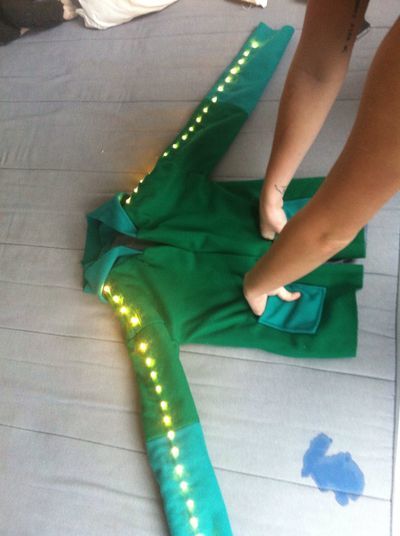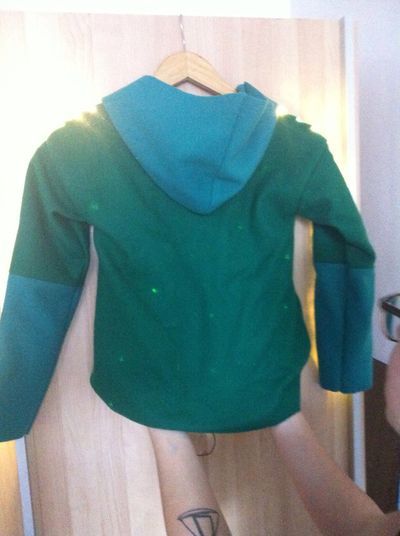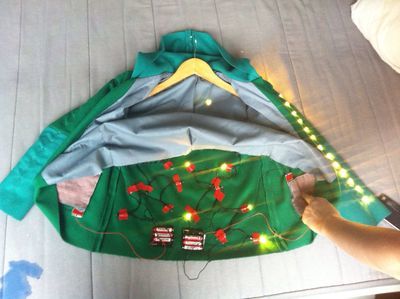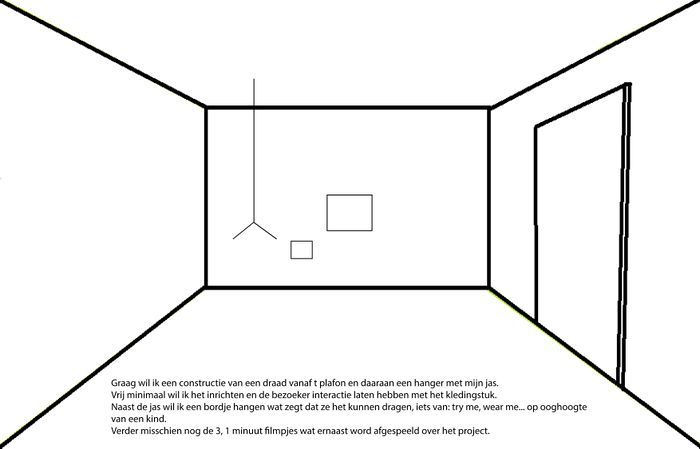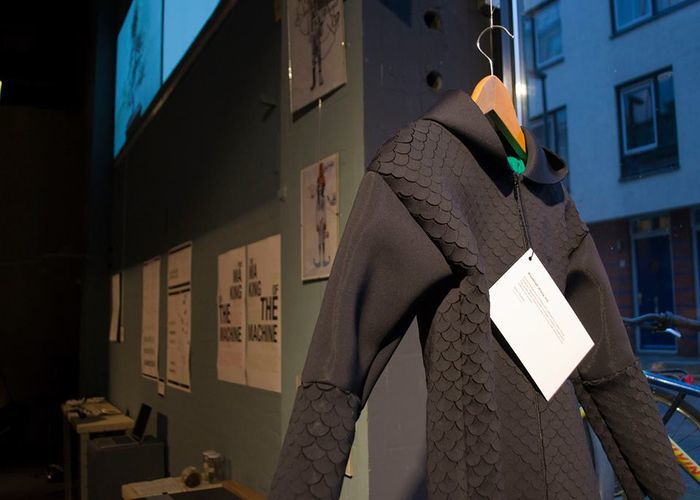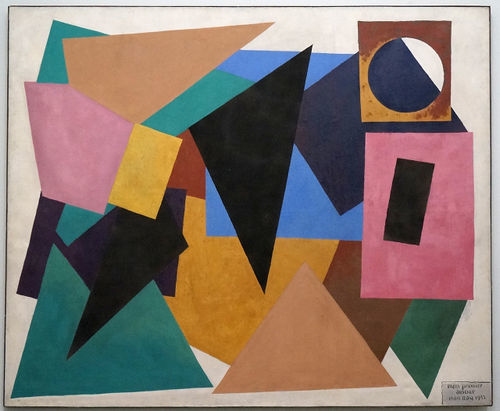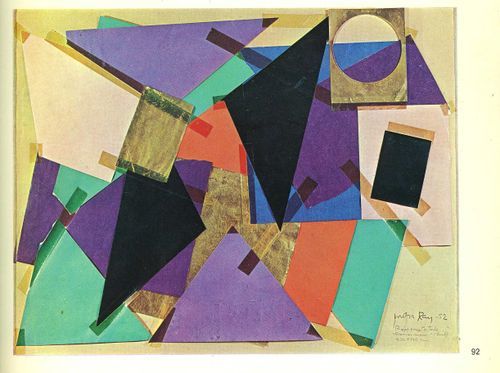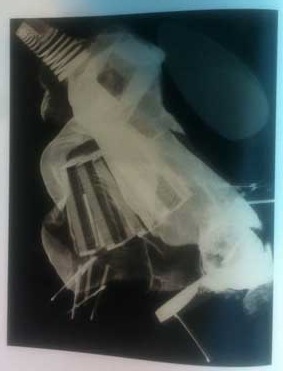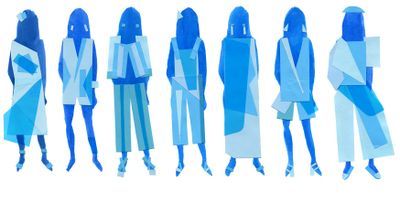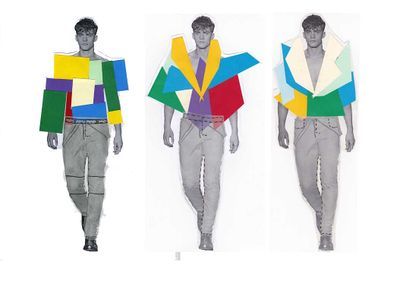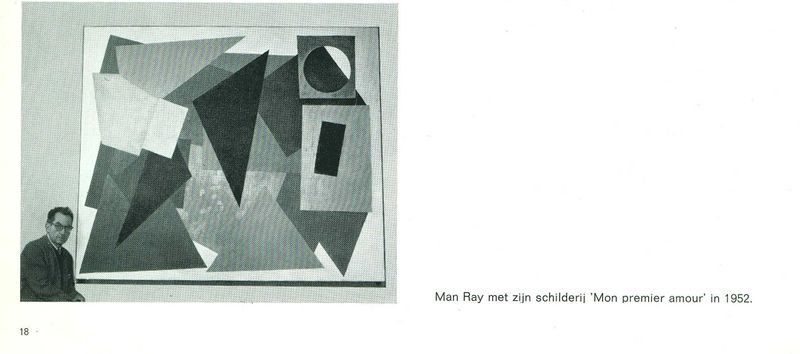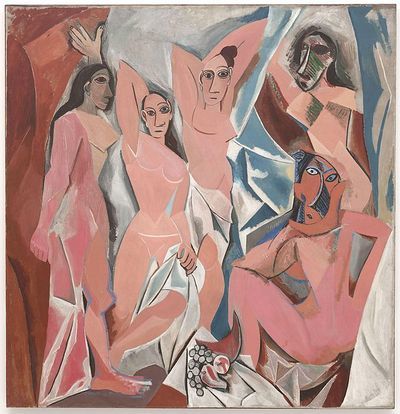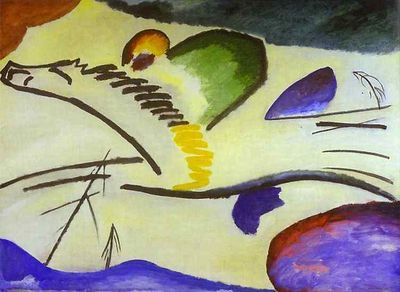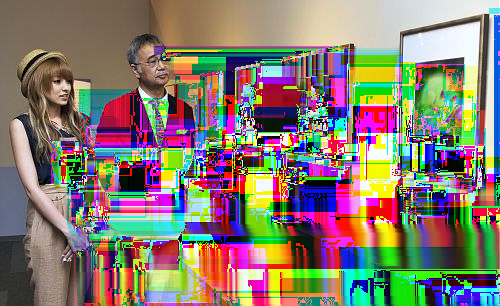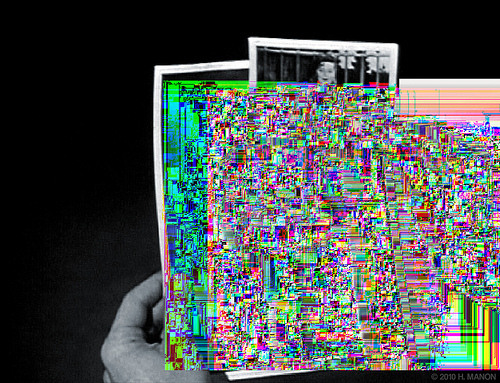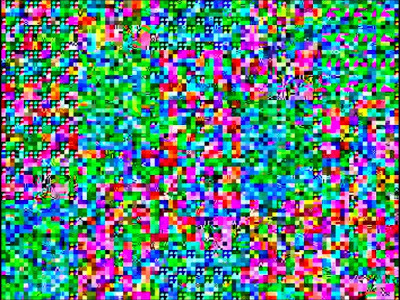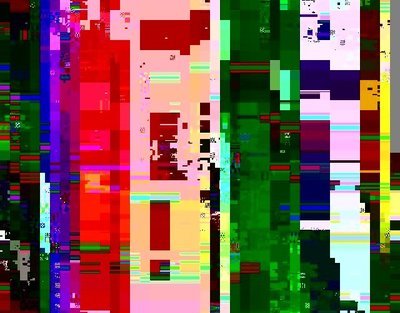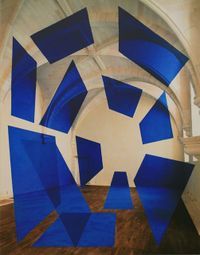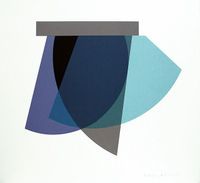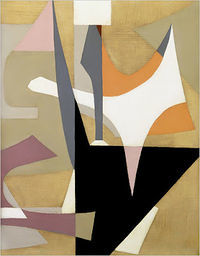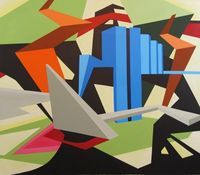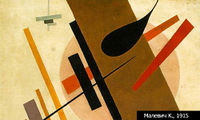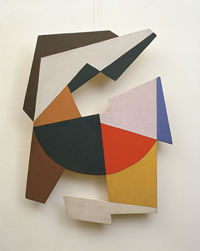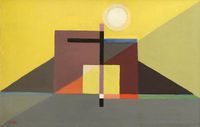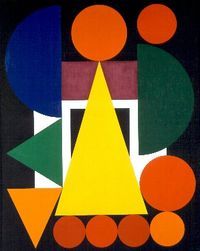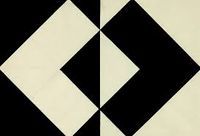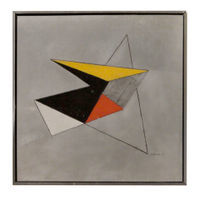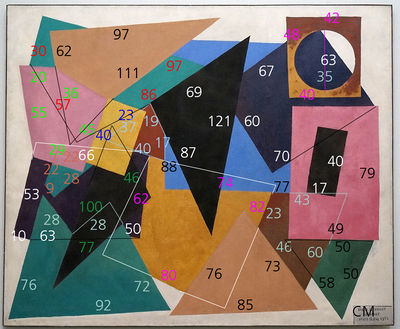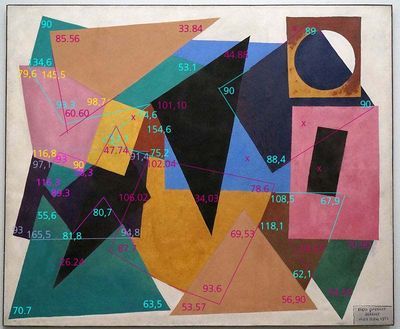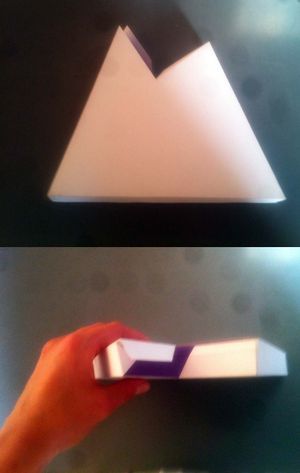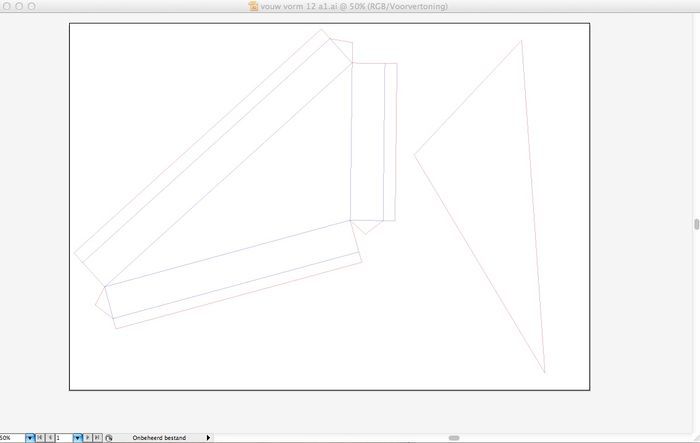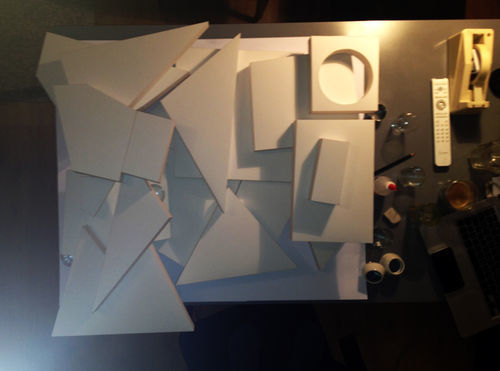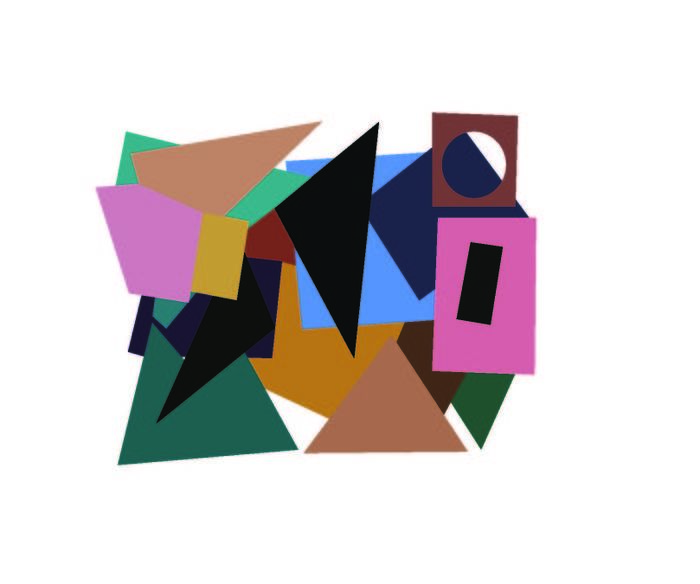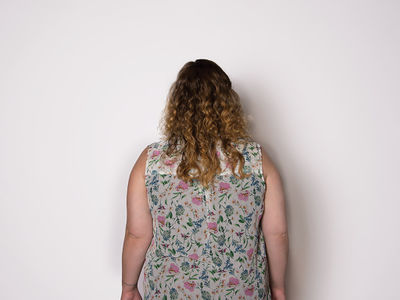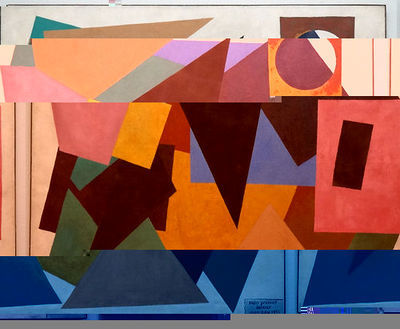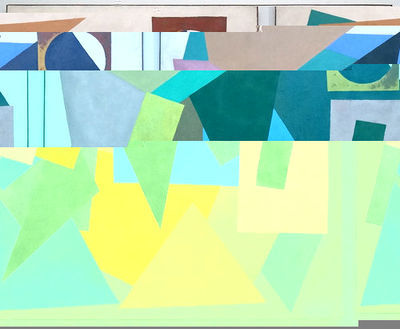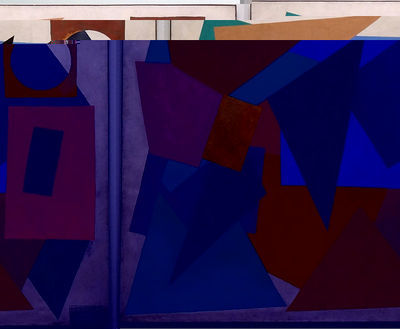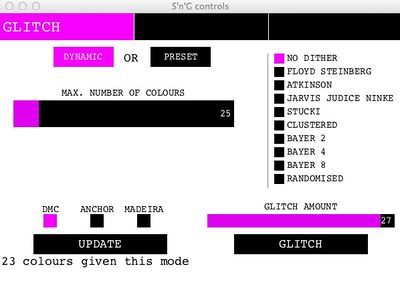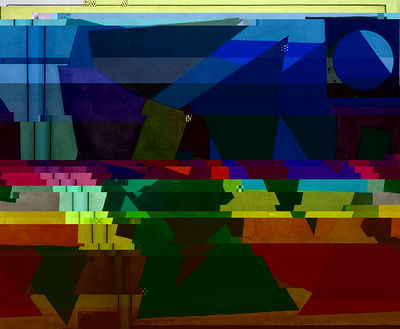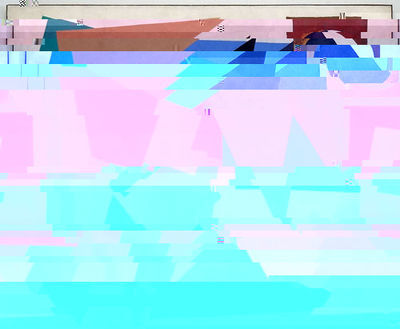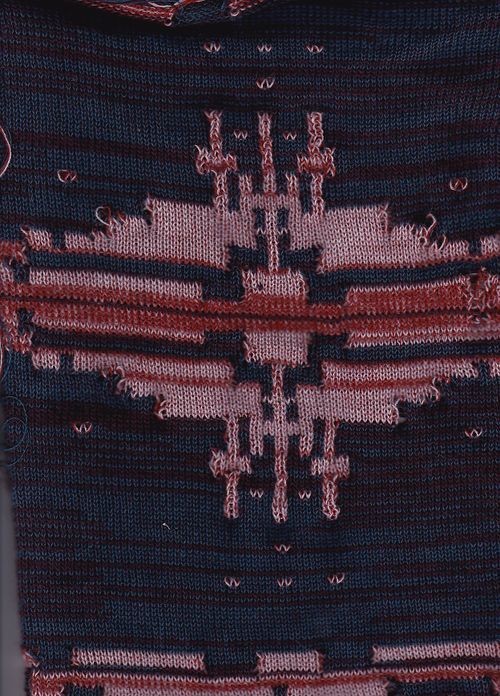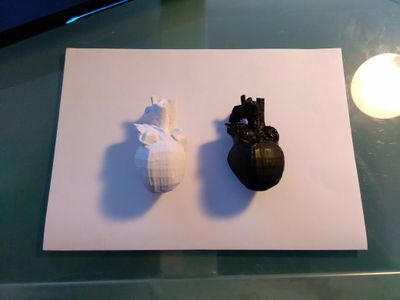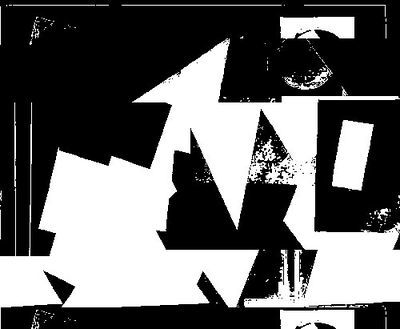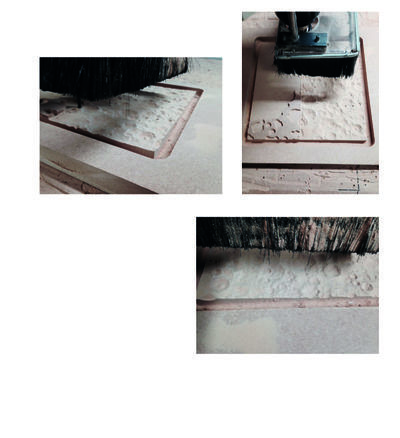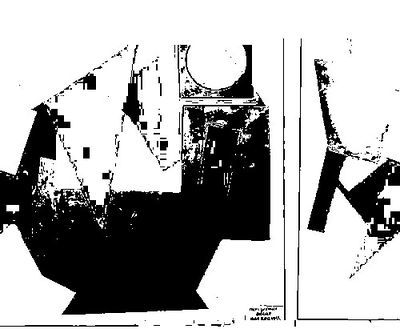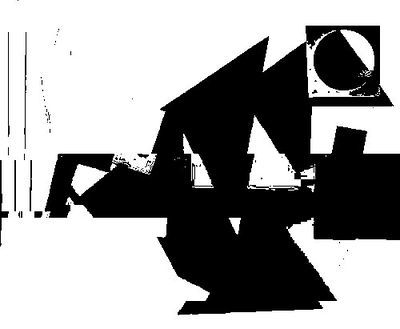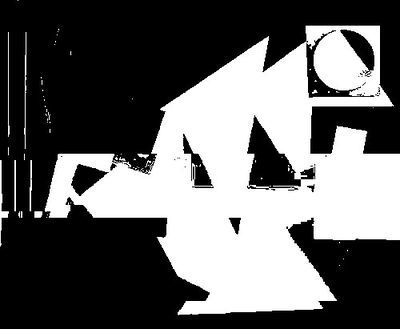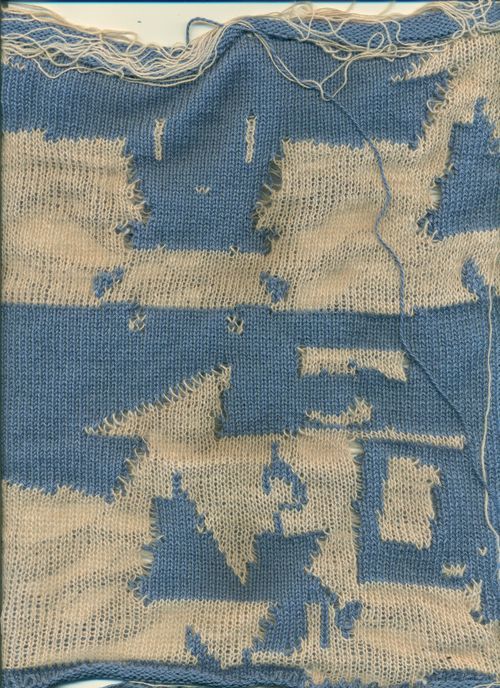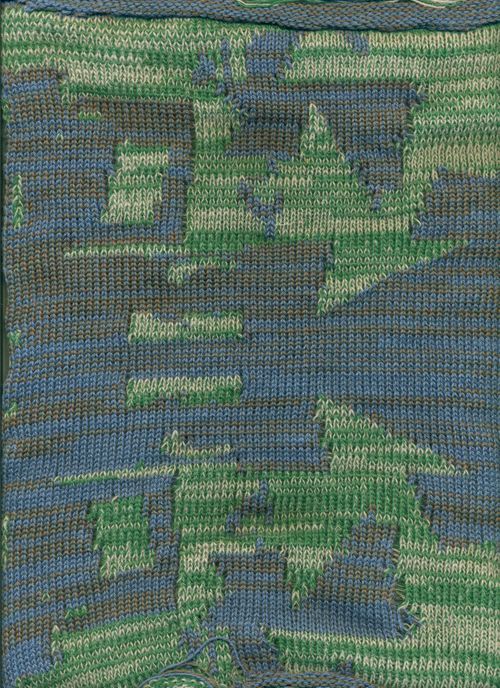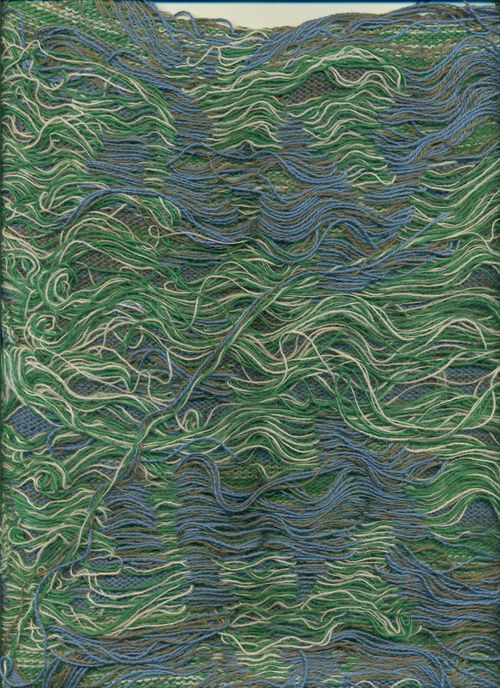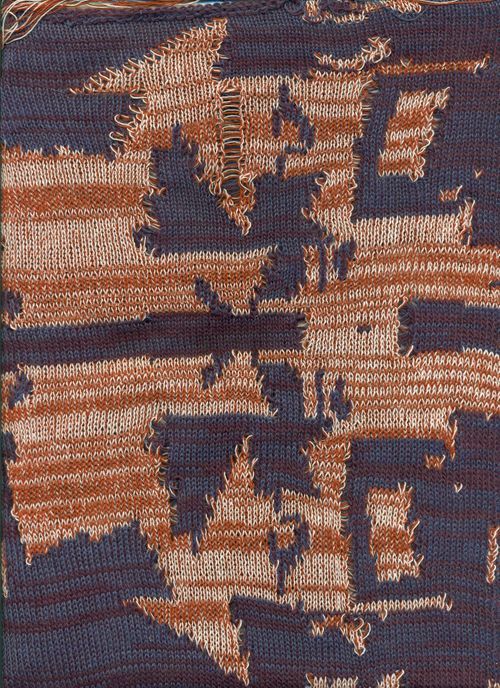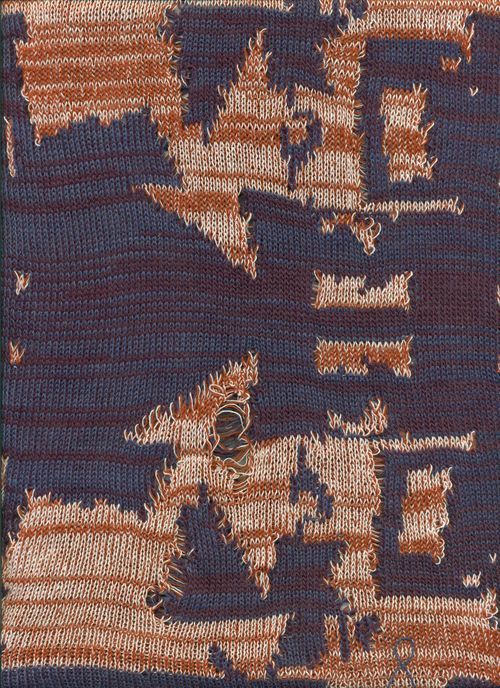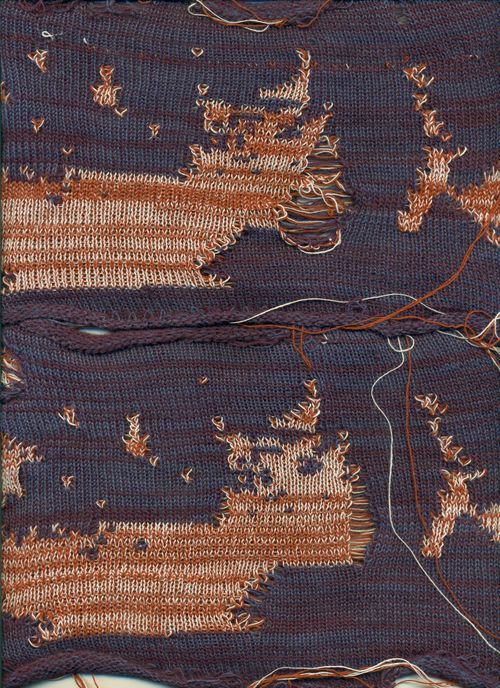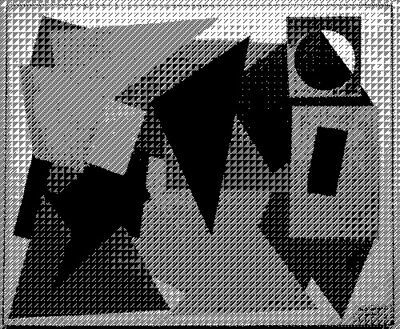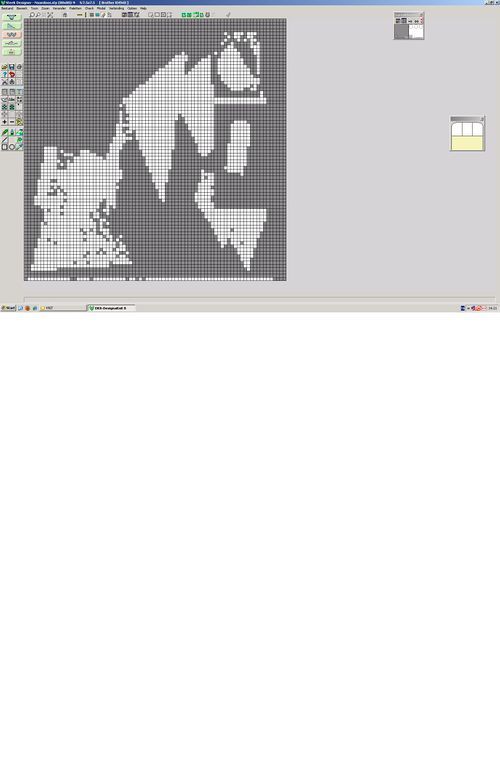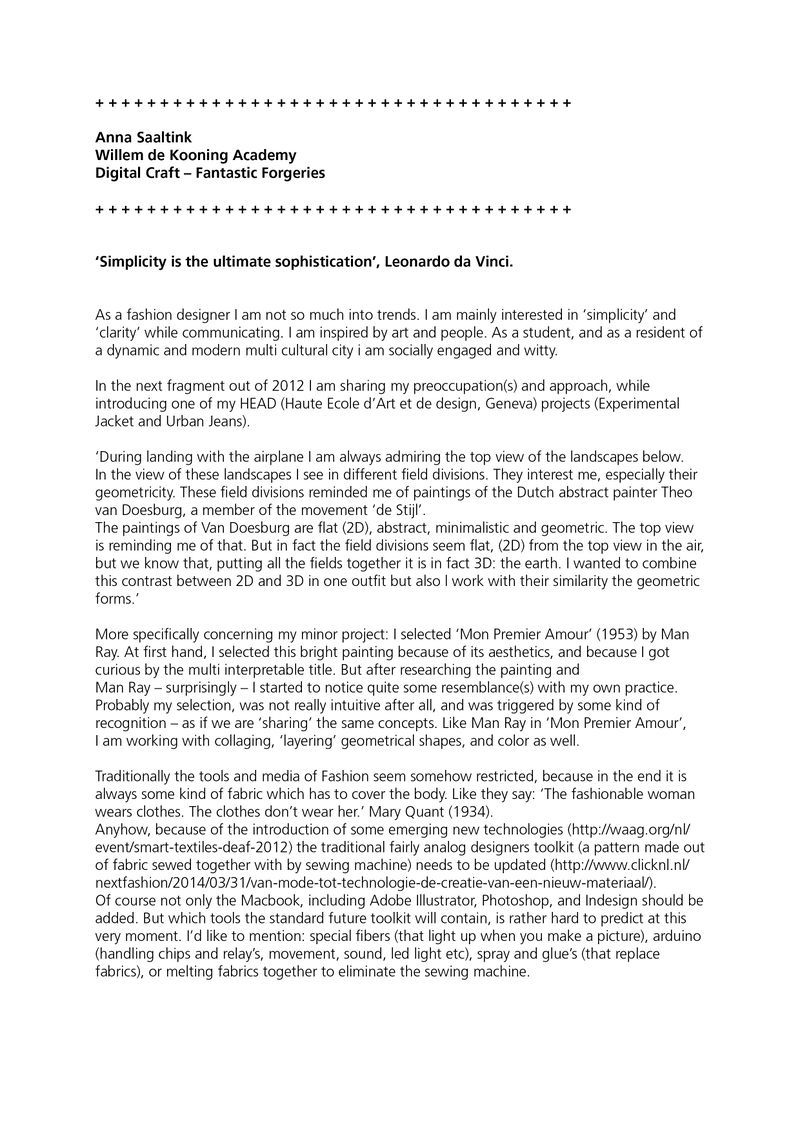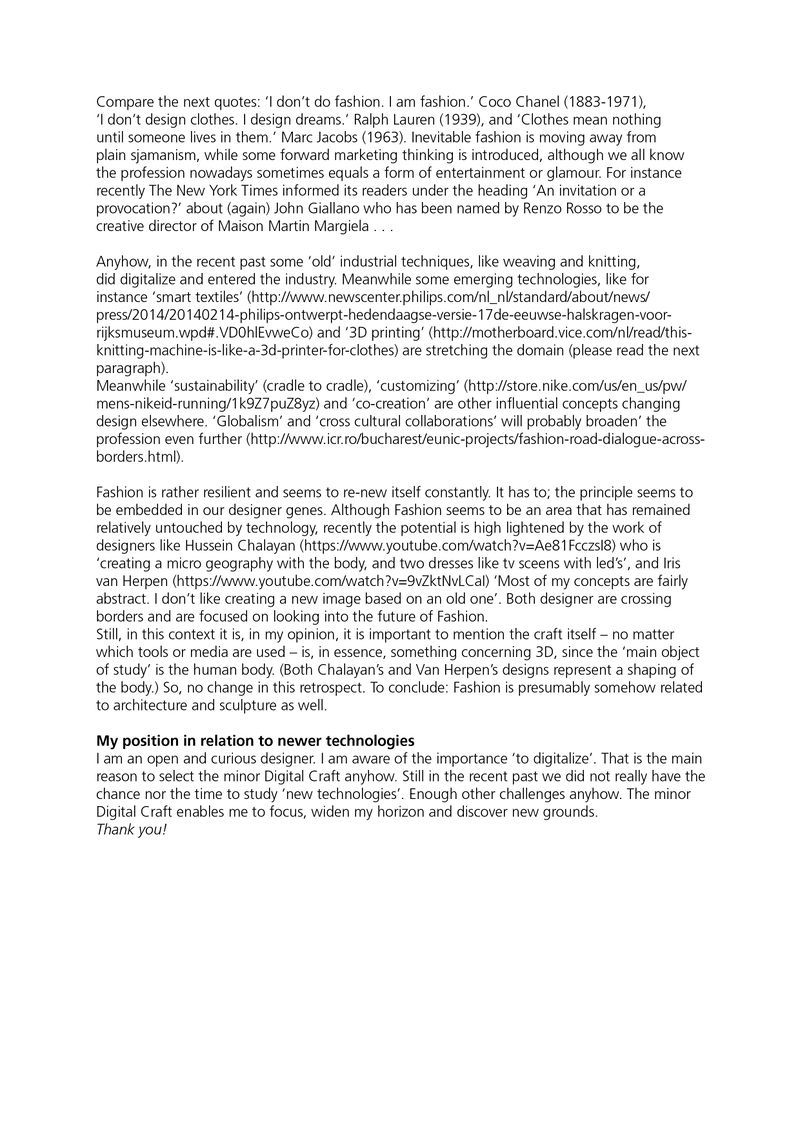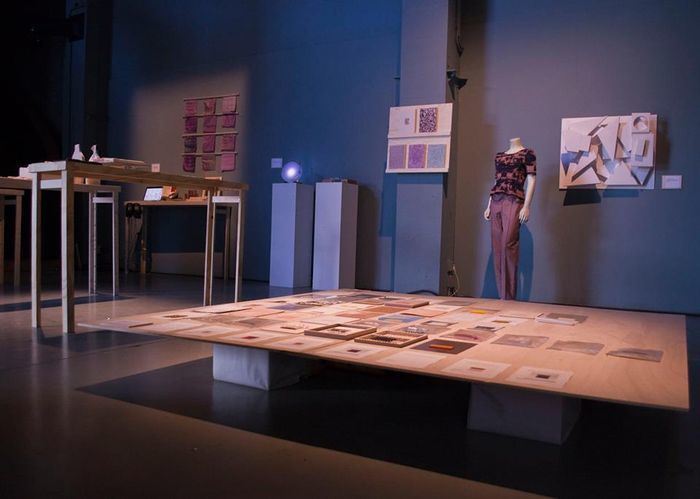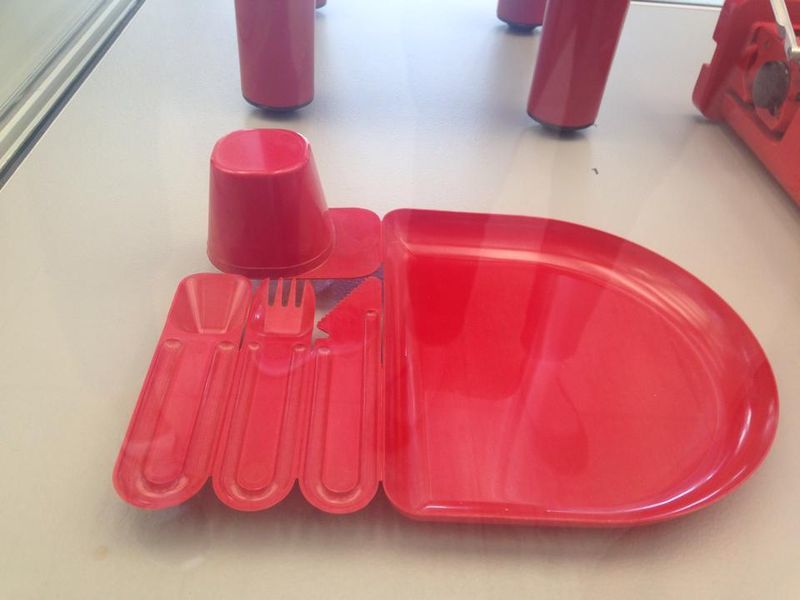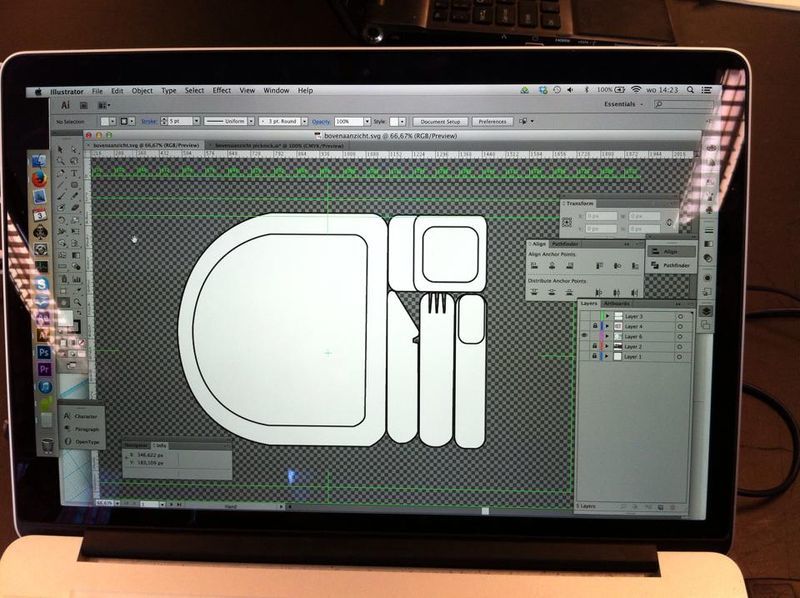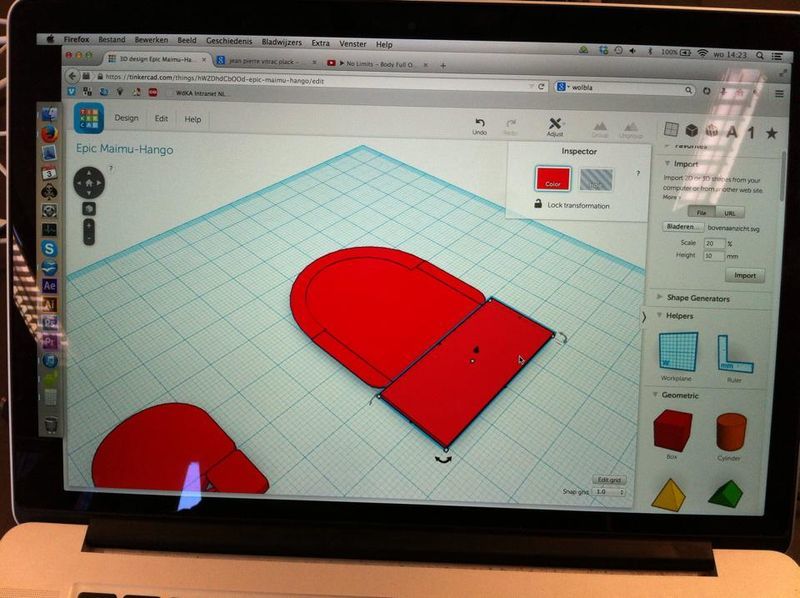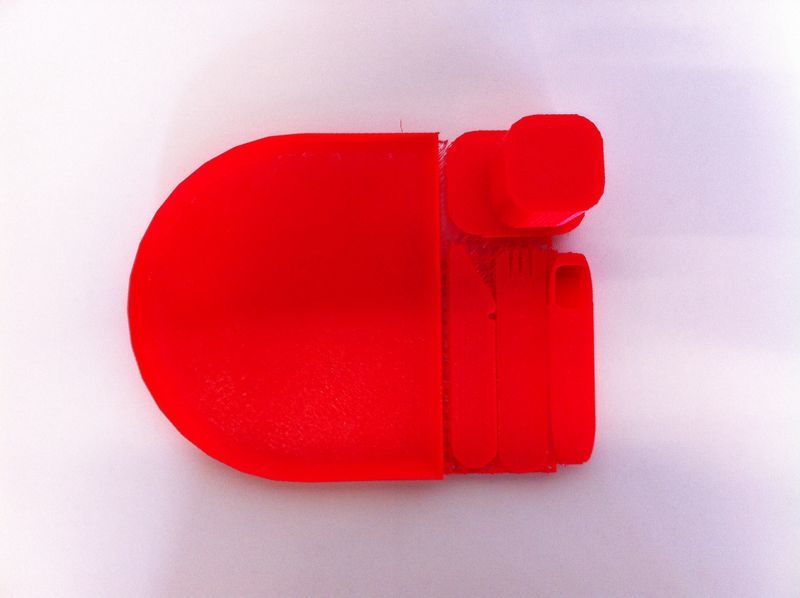User:Anna.saaltink
Graduation
Motivation & research questions project plan
Ik vind het verontrustend dat tegenwoordig de meeste kinderen verslaafd zijn aan beeldschermen. Naast dat dit veel negatieve effecten heeft (concentratiestoornissen, mediaverslaving, overgewicht, niet meer buitenshuis komen enzovoorts) consumeren ze passief. Daardoor zijn kinderen minder creatief en fantasievol bezig. Ontwikkeling tot een creatieve volwassene is belangrijk voor de maatschappij als geheel en voor de persoon zelf. Daar zou ik graag met mijn collectie een bijdrage aan willen leveren. Bovendien zou ik later mijn kind niet graag willen zien als een zombie gekluisterd aan een iPad.
Ik wil een speelse interactie bewerkstelligen tussen een collectie van jassen. Deze jassen prikkelen de fantasie van kinderen en ze laat (buiten) spelen met elektronica zonder het gebruik van een beeldscherm. Zo worden de hersenen van kinderen op een andere manier gestimuleerd door zelf inbreng te geven aan het verbeeldingsspel en ze ontwikkelen zo meer hun fantasie en creativiteit.
Na het afronden van de minor was het voor mij meteen duidelijk dat ik mijn project van 'tools of the trade' verder wil uitwerken naar een collectie kinderjassen. Mijn
onderzoeksvraag binnen de minor was: Hoe kan ik fantasie van kinderen prikkelen met behulp van elektronica? Nu heb ik dit weten te
bewerkstelligen en wil ik mijn prototype uitwerken tot een collectie van vier jassen die interactie met elkaar hebben en een (fantasie) spel voor kinderen vormt.
De hoofdvraag die ik voor het afstuderen heb geformuleerd is:
Hoe kan ik een speelse interactie bewerkstelligen tussen een collectie van jassen, die de fantasie van de afzonderlijke drager (de kinderen) prikkelen?
Mogelijke deelvragen hierbij zijn:
Hoe bewerkstellig ik interactie tussen jassen?
Hoe prikkel ik fantasie op verschillende manieren?
Hoe bewerkstelling een speelse interactie?
Hoe bereik ik mijn doelgroep?
Feedback projectplan
File:Projectplan Anna Saaltink.pdf
Feedback:
Your plan is rich in ideas and potential. We do feel though that your opinion about the relationship children have nowadays with computer screens could use more research.
Since your main goal is to stimulate children's imagination and achieve playful interaction look for examples of applications for platforms such as iPad that have the same goal, and form an opinion based on what you do want instead of what you don't want.
Take a look at applications such as http://multeor.com/ in order to collect more details that form a foundation for your ideas.
Na het praten met Jon, Deanna, Jacob en Tim wil ik mijn:
- positie beter bepalen en beter beargumenteren. Beperk ik mezelf door scherm? Positief benaderen. Meer research naar de relatie van kinderen met beeldschermen.
voorbeelden van applicaties zoals ipad, wi, (technologie interactie?) zelfde doel, en vorm een mening gebaseerd op want ik wil inplaats van wat ik niet wil.
- Ik wil fantasie stimuleren en een speelse interactie bewerkstelligen maar wat is de logica hierachter? wat voegt de interactie toe? Wat onderscheid het met andere interactie applicaties (misschien persoonlijk maken door een voorbeeld kind te nemen met een stoornis?)
Onderzoek komende weken doen naar theorie en praktijk:
- Wat is interactie design (theorie)
- Hoe wil ik de interactie bewerkstelligen en op welke manier? (wat bestaat er, wat zijn mogelijkheden?)
- Spelende/ gamende kinderen (observatie van de users in hun echte speel omgeving, zo het begrijpen en meenemen in mijn ontwerp)
- Spelende/ gamende kinderen, (theorie, homo luidens, Brenda Laurel, mark Weiser)
- Hoe stimuleren fantasie (kleine prototype testen) Kinderen weten dat het niet echt is of een fantasie maar ik moet ze erin laten willen geloven, net als ik zelf doe bij bijvoorbeeld fantasie films zoals Harry Potter, Narnia, charlie and the chocola factory etc.
- De fantasie van kinderen, (interview en actie van tekenen knutselen samen tot beelden komen om mee te nemen als inspiratie voor het thema of personages van mijn collectie jassen)
- Hoe de jassen verbinden als collectie, thema? personages? verhaal schrijven? Scenario?
'scenarios provide a fast and effective way to imagine the design concept in use. In a sense scenarios are prototypes built of words. Using scenarios designers can place their personas into context and further bring them to life. What happens when the personas encounter the product for the first time? how do they know what to do and how to use the product? What does it feel like to them?'
Research about Interaction Design
Na het lezen van het boek 'designing for interaction' van Ben Saffer en 'The elements of user experience' van Jesse James Garrett ben ik een stuk wijzer over wat interactie design inhoud, hoe het is ontstaan en op wat voor manier ik mijn project kan aanpakken en dat mijn project goed aansluit bij 'wat interaction design; is.
Wat is Interaction Design:
Een interactie ontwerp kan vele vormen aannemen. Het kan betrekking hebben op het gebruik van huishoudelijk apparaten, de pinautomaat, de taxicentrale, de computer en softwareprogramma’s tot mobile devices. Wat al deze dingen met elkaar gemeen hebben is dat ze de gebruiker moeten verbinden met de producten die ze gebruiken.
Interaction design gaat om het gedrag van mensen en is veel moeilijker te observeren dan de verschijning van mensen. Bij interaction design gaat het om het oplossen van specifieke problemen onder zijn eigen omstandigheden, zoals de tijd waarin we leven, de mogelijkheden van de techniek en ontwikkelingen van nieuwe methodes.
Interaction design is meer een toegepaste kunst. Het gaat om het verbinden van mensen doormiddel van producten en diensten. Als interaction designer ben je gefocust op users. Door het bouwen van prototypes en deze te testen, komt men tot een oplossing voor het probleem. Informatie moet worden verzameld en verwerkt om tot een goed interactie ontwerp te komen.
Bij interaction design veel samengewerkt met mensen uit andere disciplines. Zelf beslaat interaction design ook veel velden uit overlappende disciplines. Hierdoor is het soms moeilijk om te omschrijven wat interaction design nu precies is en wat het niet is.
3 ways of looking at Interaction Design:
1. The technology centered view
Interaction designers make technology, particularly digital technology, useful, usable, and pleasurable to use. This is why the rise of software and Internet was also the rise of the field of interaction design. Interaction designers take the raw stuff produced by engineers and programmers and mold it into products that people enjoy using.
2. The behaviorist view
As jodi Forlizzi and Robert Reimann succinctly put it in 1999 in their presentation 'interaction designers: What we are, what we do & what we need to know,' Interaction design is about defining the b heavier of artifacts, environments and systems (for example products). This view focuses on functionality and feedback: how products behave and provide feedback based on what people engaged with them doing.
- Interaction design products require and respond to human input, and change their own content or behavior based on that input
3. The social Interaction Design view
The third and broadest view of interaction design is that it is inherently social, revolving around facilitating communication between humans through products. This perspective is sometimes called: social interaction design. Technology is nearly irrelevant in this view; any kind of object or device can make a connection between people. These communications can take many forms; they can be one to one as with a telephone call, one to many as with a blog, or many to many as with the stock market.
Korte geschiedenis van Interaction Design:
Bill Moggridge named it in 1990. But began probably already in prerecorded history (single/multi part tools, mechanical motion, animals, water, fuel (stoom).
1930 - Samuel Morse - system electromagnetic pulses into a language of sorts and communicate those words over long distances (telegraph). Other mass communication technologies (radio, telephone, television). They responded to human input, certainly but not in a sophisticated way. (need of the computer).
1940/1960 - First computers were engineered not designed. Humans had to adapt to using them not vice versa.
1960/1970 - Computers became more powerful, engineers began to focus on people using computers ad began to devise new methods of input and new uses for the machines.
1970 - computer gaming industry came up, shifting focus from the computer hardware to the software that runs it.
1980 - Emphasis on graphical user interface (apple; lisa and macintosh)
1990 - The era of networked computing and the beginning of interaction design as a formal discipline. The world wide web allowed anyone to easily publish hypertext documents. The mass adoption of email brought a need for better interaction design. explosive market growth of mobile phones and devices. Other pieces of interaction design in 1990's karaoke, video games like dance dance and the sims.
2000- now - Era of social software and computing, not a one to one relationship with devices but instead devices able to interact with each other and the Internet.
The four approaches to Interaction Design:
1. User-centered design
Focus on user needs and goals, Users are guide of design and the designer translate the user needs and goals.
2. Activity-centered design
Focus on the task and activities that need to be accomplished. Users are performers of the activity and the designer creates tools for action.
3. System design (Example: heating system in your house)
Focus on the components of a system. Users set the goals of the system and the designer makes sure all parts of the system are in place.
4. Genius design (Example: iPod)
Focus on the skill and wisdom of designers used to make products. Users are a source of validation and the designer is the source of inspiration.
Ik wil de methode: user-centered design toepassen op mijn project. Daarom hier meer informatie over:
Mensen die een product of dienst (moeten gaan) gebruiken, weten zelf heel goed wat hun behoefte, doelen en voorkeuren zijn. De designer moet zich aan hen aanpassen en ervoor zorgen dat users het doel behalen. Users weten het ’t beste, dat is het idee achter user-centered design. Daarom worden ze idealiter bij ieder stadium van het ontwerpproces betrokken.
De roots van UCD liggen in de ergonomie en het industrieel ontwerp. Producten moeten passen bij mensen en niet andersom. Het behalen van doelen is het belangrijkste, de focus ligt op wat een user uiteindelijk wil bereiken. Daarna ontwikkeld de designer de tools, maar altijd met de wensen van de gebruiker in het achterhoofd.
Een groot deel van de tijd wordt dan ook gebruikt voor onderzoek om uit te zoeken wat de doelen zijn van de users in elke situatie. In elke stap worden users gevraagd wat ze er van vinden en worden prototypes met users getest. Het nadeel kan zijn dat men doelen achter doelen gaat zoeken, waardoor een probleem veel uitgebreider wordt dan de bedoeling is. Het voordeel van UCD is dat je als designer je eigen wensen en voorkeuren opzij moet zetten. Want jij bent uiteindelijk niet de gebruiker!
http://en.wikipedia.org/wiki/User-centered_design
Design Strategie:
1. Research & Observations
2. Analysis
--->
3. Structured insights
--->
4. Ideation & Principles
5. Refinement
--->
6. Protoype/development
Design Research and observations methods:
Observation:
1. Fly on the wall - Go to a location and unnoticeable observe what goes on there.
2. Shadowing - Follow users as they go about their routines. This technique usually requires permission.
3. Contextual inquiry - A variation on shadowing, contexual inquiry involves going to the subjects location and asking questions about their behaviors, such as 'why are you doing that?'
4. Undercover agent - Observe people by interacting with them covertly posing as someone 'normal' in the environment.
Interviews:
1. Directed storytelling - Ask users to tell stories about specific times they performed an action or interact with a product or service.
2. Group focus- Assemble a group of users in a room to talk about a subject or service
3. Unfocus group - Assemble a group of experts in the field, hobbyist, artists and others to explore the subject from a different viewpoint.
4. Role playing - With a willing group or individual, role playing different scenarios can draw emotions and attitudes about a subject or product.
5. Extreme-user interviews - Designer interviews people on the outer edge of the subject matter (for example working on a tv project interview people who don't own a tv).
Activities:
1. Collaging - using images, words, paper, scissors etc with users
2. Modeling - clay, styrofoam blocks, cardboard etc with users
3. Draw your experience - Give subjects drawing materials and paper and tell them to draw their experience with a product or service.
De elementen van Interaction Design:
Onafhankelijk van welke methode je gebruikt om een probleem aan te pakken, zijn er altijd een paar elementen die meegenomen moeten worden in de oplossing. Interaction design kent een aantal principes en wetten die je als handvaten kunt gebruiken om de blokken van het interactie ontwerp op te bouwen.
Beweging
Objecten die niet bewegen kunnen niet interactief zijn. Interactie is een vorm van communiceren en communiceren gaat over beweging. De beweging ontstaat doordat we gedrag aan mensen en producten koppelen. Producten en mensen reageren op impulsen die zij van andere producten of mensen krijgen. Beweging wordt gekleurd door de houding, cultuur en persoonlijkheid en de context waarin men zich bevindt. Iemand die oud is, zal langzamer en met meer voorzichtigheid reageren op een nieuw product dan iemand die jong is en gewend is dit type product te gebruiken. Beweging is dus altijd een trigger voor een actie.
Ruimte
Beweging vindt altijd plaats in een bepaalde ruimte. Ruimte hoeft niet per definitie een afgebakend terrein te zijn. Ruimte is dan niet vast te pakken. Je hebt op die manier digitale, analoge en fysieke ruimte. Het internet is een voorbeeld van digitale ruimte. De kamer waarin men zich bevindt is een fysieke ruimte, je bent er fysiek aanwezig. Vaak vindt interactie plaats in een ruimte dat een combinatie is van digitaal en fysiek. Voor het interactie ontwerp is het goed om te weten in welke ruimte een product of dienst wordt gebruikt. Het maakt veel verschil of interactie thuis achter het beeldscherm is of dat het op een druk station in een kiosk plaatsvindt.
Tijd
Tijd is een derde factor dat interactie mogelijk maakt. Zonder tijd is er geen beweging mogelijk. Het kost namelijk tijd om van het ene punt naar het andere punt te bewegen. Dit kan om miliseconden gaan bijvoorbeeld bij een muisklik. Voor een interaction design is het belangrijk om te weten wat de factor tijd doet met mensen. Digitale tijd is niet het zelfde als de tijd die men waarneemt in de fysieke ruimte. Digitale tijd is opgedeeld in veel kleinere eenheden, namelijk miliseconden. De mens kan dit amper waarnemen. Daarom worden veranderingen door computers vaak vertraagd zodat je het kunt zien. Toch merk je direct de impact van de miliseconden. Als het bijvoorbeeld een seconden zou duren dat je computer reageert op je toetsaanslag, dan zou dat je computer onbruikbaar maken. Een ander bijkomstigheid van tijd is dat het ritme kan creëren. Je krijgt een bepaalde verwachting van hoe snel een venster opent of sluit. In games wordt er veel gebruik gemaakt van ritme. Binnen een bepaalde tijd gebeuren er acties of wordt een level afgesloten.
Vorm
De vorm van een apparaat geeft een indicatie van hoe we hem moeten gebruiken en hoe het reageert op onze acties. Vorm, grootte, kleur en gewicht zijn elementen die bepalend zijn voor de functie van een apparaat. Hierdoor veronderstellen wij hoe wij het kunnen gebruiken. Deze kennis cultureel en contextueel bepaald. Je weet hoe iets werkt omdat je het eerder geprobeerd of gezien hebt.
Aan een vorm wordt een functie gekoppeld. Die vorm moet voldoen aan een of meerdere voorwaarden voor het geschikt is voor die functie. Als iets hol is, dan kunnen we het vullen met bijvoorbeeld drinken. Maar het heeft als extra voorwaarde dat het geen gaatjes aan de onderkant mag hebben, want dat kunnen we het beter gebruiken als vergiet. Daarnaast betekent vorm ook emotie. Aan de buitenkant kun je zien of het een serieus ding is of een speeltje. Je kunt zelfs zien of iets waarschijnlijk erg duur is of heel goedkoop. Complexiteit, praktische waarde, levensduur en ga zo maar door zijn ook af te lezen van de vorm. Als interaction designer moet je voor bijna elk product de vorm ontwerpen die erbij past. Kijk hierbij onder andere naar kleur, formaat, structuur, vorm, gewicht en de proporties ten opzichte van andere objecten.
Textuur
Textuur kan een onderdeel zijn van de vorm. De informatie over hoe iets voelt kan de zelfde informatie bevatten als hoe iets eruit ziet. Maar het is een andere dimensie. Vorm heeft meer met zien te maken, terwijl textuur met gaat over voelen. Voor blinden is textuur vaak van groter belang dan de vorm. Textuur gaat over de hardheid of zachtheid van iets en daarmee tevens over emoties. Een knuffelbeer is zacht en nodigt uit tot vastpakken en knuffelen, maar schuurpapier houden we het liefst zo ver mogelijk van ons gezicht vandaan. De functie van een product verandert wanneer zijn textuur verandert. In het voorbeeld van de beer kan een glazen beer eerder voor decoratie zijn dan om mee te knuffelen. Textuur heeft meerdere dimensies. Vibraties en temperatuur zijn andere aspecten van textuur. Door warmte of kou kun je een bepaalde boodschap aan een product meegeven. Een telefoon kan trillen wanneer een bericht binnenkomt.
Geluid
Audio erg belangrijk bij interactie. Vooral waar het gaat om waarschuwingen en apparaten die op de omgeving reageren, geeft audio een extra dimensie aan de boodschap. Zelfs een klein beetje geluid, kan een belangrijk verschil voor een product betekenen. Geluid heeft enkele elementen waardoor het herkenbaar is voor de user. Dat zijn de frequenties, volume en toonhoogte. Ze gaan over de warmte van een geluid, de hardheid en het type geluid. Iets wat de zelfde frequentie en volume heeft, kan door het verschil in toonhoogte anders klinken. Zo klinkt een trompet anders dan een keyboard ook al spelen ze hetzelfde.
Tools of the trade
Theme
I am by nature an optimistic and enthusiastic person. I love children and the way they experience/see the world. Fashion should be and stay something fun for me. In this world there are happening so many bad things I think fashion should be not too heavily loaded, fun, happy and with a big smile.
Tools of the trade I would like to use as a pre-study for my children wear graduation collection. The theme I want to work with is children clothes combined with new technologies.
History of children's wear
Childhood was a regrettable prelude to maturity, to be over as quickly as possible. To achieve this young people were encouraged to behave and look like miniature adults. If they belonged to the upper classes, education and discipline were drilled into them from nursery stage. If poor they were put to work equally prematurely. And at the earliest possible age they were reseed almost identically as adults in the fashions of the time. Children had no say in what they wore.
The revolution in children's clothes is generally dated from round about 1770. When Jean Jacque Rousseau wrote this famous book Émile, ou de l'éducation (a moral scope) there Rousseau gives his vision on human nature and proposes a new ideal education method. In this book he concludes that each person has a unique character and needs freedom to develop without pressure or punishment, far away from city life in connection with nature. Girls were freed from their stiff, tightly fitted silks and satins, their cage like skirts. They began to wear simple straight dresses of muslin and various cottons with easy necklines and unrestricted waists. Unfortunately this was just for a short period and returned to being miniature adults as irrational and uncomfortable as anything in the past.
Fashion's was widening with the rise of the middle classes who, though class consciousness made many of them follow the mode in its extravagances, also included a strong intellectual element devoted to social reform. The whole basis of society was being questioned between 1830 and 1880. That did not in itself improve character of children's clothes. The 'century of the child' should have begun in 1900 would be beyond all logic, both as regards the clothes which were symbolize it and the new attitudes which were to be one of the main factors influencing what children wore. For infants above all the approach of the turn of the century produced no signs of liberation. Innovations did begin to come into children's dress from the twentieth century. Paul Poiret got rid of the fashion heavily boned waist constricting corsets afflicting young girls and even boys as well as adults with the evils of tight lacing. Above all he inaugurated a new way of thinking about fashion in terms of the nature figure of the young and active.
The first world war made a great difference. They went into the war in black stockings and dressed stiffly as their parents. They emerged in loose and easy clothing with bobbed hair, jerseys, soft collars and socks instead of stockings. And since then there has been no looking back.
Most of the trends of the 1920 and 1930 were however, not wholly or even mainly a children's movement, but were closely linked to a new general outlook and to widespread social changes in which children's inclusion was a measure of their newly admitted importance. The important thing was that children were embraced by them all and as children not miniature adults.
One big new recognition of the infant's needs came when in the 1950s his liberation from the long dresses of centuries began. The one piece coverall suit for babies , made from new stretch fabric was invented by Walter Artzt. Following made for all ages to two years and extended their range to include rompers, crawlers, t-shirts, underwear, tights and socks. They used strong colors, appliquéd animals and other motifs.
in 1970 life was more free, comfortable and easy so as their clothes. Children want comfort and freedom in what they wear.Two hundred years ago first steps towards comfort and freedom where taken when educationalists, reformers and poets recognized that children were not just imperfect adults who should be forced into adulthood as quickly as possible but distinct entities with their own needs. Their denims and duffle coats, bright t-shirts and sweaters are as much part of the adult wardrobe as of their own smaller one. Children and grown ups are again dressing a like but in a new way. It is a way that breaks all the established rules of fashion. There is no conventional status symbol significance in them.
First research/ safety rules
Parents spend a lot on money on clothes for there children even though they grow so fast they will not fit in them anymore after a couple of weeks. Buying and producing all these clothes is not sustainable and with the raw materials in shortage? Also the way it is produced, child labor for children clothes? Yes off course children grow but there can be a better solution? Maybe I could be possible to make garments that grow with you, like you have with some furniture. Or make clothes more multifunctional? Or that you can add pieces at garments like a extended puzzle.
Or garments with a GPS system, never lose your child Or garments with airbag or a textile what feels normal but is hard as rock, as a safety protection.
While thinking about children's wear I thought about all the safety rules for producing children's clothes. You have some restrictions for designing children's clothes. I wanted to know these restrictions and what will be the border?
I did research about these safety rules and it is hard to find because they are protected. As a company you have to buy it. They are safety rules for the children wear in the EU. I read quite a lot about it but not the concrete rules. I read it is mostly about the drawstrings in the clothes. This is the information I found about it and the preview what will be in the document you have to buy from this page and you can see a preview: http://www.nen.nl/NEN-Shop/Norm/NENEN-146822007-en.htm
♦ ischemic injuries (afknellen)
♦ entrapment of the penis in zips
♦ injuries from sharp objects
♦ choking, aspiration, swallowing and suffocation (denk ook aan loslatende prints!)
♦ strangulation, entrapment (zoals door te lange koordjes)
♦ restriction of vision and hearing
♦ overheating
♦ slipping, tripping and falling (denk ook aan koordjes waardoor je aan trappers of zadel kunt blijven hangen)
Drawstrings in de taille en capuchonkoordjes of een riem met gesp: wanneer mogen ze volgens de Europese norm nu wel of niet? Modint verwacht controles op de veiligheid van kinderkleding tijdens aankomende editie van Kleine Fabriek. Voor oudere kinderen zijn de regels minder streng dan voor jongere kinderen. Voor het kind tot 7 jaar (maat 134) mogen koordjes helemaal niet, terwijl verstellummels (adjusting tabs) en loshangende versiersels maximaal 75 mm lang mogen zijn. Voor oudere kinderen mag een trekkoord in de capuchon wel, mits de eindjes in een lus (korter dan 15 cm) zijn vastgezet. Ook halterkoordjes van een (bikini)top moeten vastzitten.
De regels over koorden en treksluitingen in kinderkleding (te) vaak geschonden (NEN – EN 14682)
Een kind gaat van een glijbaan en een knoop aan het uiteinde van een trekkoord van een muts blijft steken in een kleine gleuf aan het begin van de glijbaan. Het koord trekt strak terwijl het kind de glijbaan afglijdt en wurgt het kind. Een kind stapt uit een bus waarbij een sluiting van een trekkoord om de middel van het kind tussen de deuren van de bus blijft steken. De bus rijdt weg en trekt het kind mee. In 2008-2010 is er een grootschalige actie geweest in Europa, waar meer dan 10 lidstaten aan meewerkten. Uit controles bleek dat ongeveer 1 op de 8 kledingstukken niet aan de eisen voldeed. Bijna 70% ging het om kleding voor kinderen onder de 7 jaar.
De normen geven eisen voor kleding van kinderen tot 14 jaar De normen zijn onderverdeeld in twee hoofdcategorieën: Kinderen tot 7 jaar, overeenstemmend met kinderen tot 134 cmlang; Kinderen van 7 tot 14 jaar, overeenstemmend met een hoogte groter dan 134 cm en tot en met 182 cm voor jongens en 176 cm voor meisjes. De normen bevatten onder meer de volgende regels: Geen koorden of treksluitingen toegestaan in de muts of in de buurt van de nek van kinderen tot 7 jaar oud; Geen koorden toegestaan langer dan140 cm in de borststreek of rond de taille.
Inspiration
The perception of a child
After doing research about the safety rules and the other restrictions producing children clothes I got lost and less inspired by the theme. These rules are not really interesting for me as a designer and not very meaningful to me. I went back to the start of my research and asked myself why I wanted wanted to take children wear as my theme. I found it in my 5 sentence statement: I love children and the way they experience/see the world. This can be my starting point.
How do children see/ experience the world?
A child observes objective, Sees differences. Is curious. They don't judge or assign values.
A child is is experimenting and tries and is not so concerned about mistakes or isn't trying to avoid them.
A child can react pure, honest not like us already thinking about the possible consequences.
Every child is off course different how they experience the world. I think is up to different things.
- Etnique backround
- Social background
- Cultural background (norms and values you learn from your parents)
But next to that a child has his/her own characteristics (karaktereigenschappen).
The way a child is experiencing the world is depending on his age.
Baby (0-1) Dreumes (1-2) Peuter (2-4) Kleuter (4- 6) Schoolkind (6-13) Puber (12- 17)
http://nl.wikipedia.org/wiki/Kind_(leeftijdsgroep)
2 till 4 year olds have a lot of trust in their parents and live in a relative safe environment. This gives them trust to discover and learn in a playing way. They still have a lot of imagination and are sensitive for external stimuli. Also, they often have to lifeless things a soul, which is called animism. They want to discover everything themselves and they use all their senses. They are not set very task-oriented, but want immediately result. Their are still egocentric.
4 till 6 year olds the perception world is getting bigger and has more order and structure. They do not understand everything about the world and use their own fantasy to make it as a 'logical' total. Fantasy and reality are mixed together. They explore the world by asking questions, taking 6 year olds ask for more about the reason than 4 year olds. At this age the children are more interested in construction materials such as Lego.
8 till 12 year olds reality is the center. The want to deepen a lot of subject. They get more insight on social relations and play more group games. Most of them learn abstract reasoning. They get a own opinion and are guided less by the values of parents and teachers and standards but it is getting increasingly more important what friends or classmates think
Because the experience of a child is so depending on her/his age it is maybe a good idea if I choose a muse/ example as a child and I imagine/ design from his/her state of mind. I want to design for a child between 4 till 6 years old. For me the interesting thing about them is that fantasy can real for them. They mix their own imagination with reality to make it a logical total.
They live in 2 worlds: a real world where everything is visible, hearable and touchable. And a fantasy world, where the imagination of a child is playing a big part. What children don't know, they fill in with their own imagination. They think that with their thought they can influence what may happen. They call this also 'magical thinking'. Children can make up all sorts of thinks and is also playing with reality, a spoon is a microphone, a stuffed animal is a real animal etc.
I want to blur boundaries between fantasy and reality. create a tool to trigger fantasy!
First ideas:
BUDDY
A lot of children have a imaginary friend. This friend can be a way to experience the world. This imaginary friend understands more and dares more then they do. This is a creative way to explore as a child.
Buddy is more then just a clothing piece, this interface has a own life/ soul, it know emotions, can talk. It can be hard, soft, energetic, gives light but can also sleep.
NORDIC (wintercoat)
This coat breaths (sort of blood pressure sensor?) this will excites the fantasy (imagination) of young children.
- animals who are going in hibernation (turtle, frog, salamander etc)
- coat that snores.
- a heating in the coat.
HELP
This is a smart interface, it helps children in a playful way with for example:
- dressing up (this can be a struggle)
- stops biting nails
- helps learning how to talk
After rethinking these ideas are to functional and I fill in what I think children will like or want to use. I think it will be more interesting for my project to design garments together with children. Not adults deciding what children should wear. Making children wear for children with children.
I admire the perception world of a child because their thinking is pure, honest and not already influenced by norms, values and knowledge. Their think out of the box and are not afraid to tell so. They are willing to try without being afraid to fail, for example I know I can not draw, so I don't but as a child you just don't care. All kids are artists!
The story Bor told me about his uncle is a good example what I mean to say. His uncle lives (antikraak) anti squat in a gymnasium because he is to poor to rent a nice apartment. His nephew came to visit him and was so excited his uncle was living in a gymnasium, for him this had a whole other value than it in reality is. He told all his friends his uncle was very rich and lived in a gymnasium all for him self.
Because I wanted to do something with new technologies I decided to do some experiments with children and a electronic device. I took an iPad because this is an object that is very popular with children and I was sure they could tell me a lot about it and they would be excited because they are all addicted to the damn thing (haha). Besides I don't know a lot about electronics and how an iPad works so I wanted to discuss with them the possibilities what would be inside and how it was made or is functioning.
This as a inspiration: http://vimeo.com/58652459
Experiments
Het eerste jongetje waar ik langs ging was Abel (7 jaar). Dit was een een ontmoedigend interview. Hij zei dat hij dacht dat er een apparaatje in zat maar meer wist hij niet. Tekenen van dit apparaatje zat er ook niet in. Ik vroeg mezelf af of dit lag aan hoe ik de vragen formuleerde of aan hem als kind. Zijn moeder vertelde me dat hij erg realistisch is ingesteld en weinig heeft met fantasie. Abel verwees me door naar Hein, zijn beste vriend die volgens Abel veel meer bezig was met fantasie. Abel is een erg wereldwijs jongetje.
Gelukkig had ik bij de volgende kinderen meer succes. In totaal heb ik 10 kinderen geïnterviewd. Ook heb ik contact gelegd met een Rudolf Steiner basisschool in Den haag en een creatieve BSO in Amsterdam waar ik van de week nog langs ga.
Hieronder zijn alle tekeningen die kinderen hebben gemaakt van de Ipad. Ik merkte dat alle kinderen ondanks het leeftijdsverschil super veel wisten over electronica. Een jongetje van 7 kon zelfs een prietpraat en geheugen chip voor me tekenen en uitleggen hoe dit werkte. Ook kwam ik er snel achter dat de kinderen heel goed fantasie van realiteit kunnen scheiden. Als ik ze vroeg hoe denk je dat het werkt of wat zit er achter het scherm zeiden ze: draadjes, batterijen, elektriciteit maar er kwam geen fantasie naar boven. Ik wist ze wel te sturen door de vragen wat als je zelf een ipad kon bouwen? of fantaseer eens wat het zou kunnen zijn, dan kwamen de gekste en leukste verhalen naar boven.
Hein: Electriciteits draadjes, met plankton van spongebob erin die met mijn een ogig oog door de camera mee kijkt
Hein: binnenkant van een ipad, met een astronaut die een speicaal pak aan heeft zodat hij tussen de draadjes kan klimmen zonder geëlektrocuteerd word, hein zou graag zon astronauten pak willen en zelf een kijkje in een ipad nemen.
Allemaal verschillende dieren die volgens kinderen in een ipad zouden kunnen zitten inclusief zelfverzonnen dieren zoals girafant.
Frauke: Volgens haar woont er een familie van een moeder, vader en kind in een ipad. Om de beurt beweegt hun vinger mee aan de binnenkant van het scherm met die van jou en zo werkt het touch screen.
Indy: fantasie knutselwerkje van een ipad hoe ze het zelf noemde. Een een ogig monster en een haai
Impressie van een ipad door Zita (4 jaar)
Celine tekende hier de binnenkant van de ipad. Ze legte me uit dat alle draadjes aan elkaar verbonden waren en aan een kastje. In het kastje zaten lampjes die aan zijn als de ipad aan is. Alles word door de ipad naar een satelliet gezonden in de ruimte en terug.
Maja van 6 tekende hier de binnenkant van een ipad met prietpraat en uitleg wat er gebeurd als je een knopje indrukt.
Printplaat, geheugen chip alles kon Youri van 6 me uitleggen en voor me tekenen, ik stond met een mond vol tanden. Zijn vader is ingenieur maar vertelde me later dat hij geen idee had hoe zijn zoon dit allemaal wist.
Reflection experiments
Tijdens het onderzoek vond ik dat de kinderen wel vrij dachten over hoe een touchscreen werkte, of het was een magneet, of een familie die met hun vingers mee bewogen ze hadden er allemaal een idee van daarom wilde ik iets doen met een touchsensor in een kledingstuk. Ik heb met Simon besproken of ik een touch sensor zoals die in een ipad zit in een kledingstuk zou kunnen doen maar dan zou het een klein oppervlak zijn en dat wilde ik niet of onmogelijk om zelf te maken omdat in een ipad heel veel kleine touch sensoren zitten. Gelukkig zijn er verschillende manieren om deze touch sensor te maken. Ik heb een testje gemaakt met 2 laagjes aluminium en een een laag van mash ertussen dat als je erop drukt het aluminium contact maakt en geleidt waardoor de sensor werkt. Dit was ideaal omdat het dun materiaal is en buigzaam dus goed mee te naaien in kleding.
Ik realiseerde me dat ik me een verkeerde voorstelling had hoe kinderen zouden reageren met hun fantasie op een electronisch object zoals een ipad. Ik had verwacht dat dit veel meer zou leven en vrijer zou zijn. Eigenlijk was het allemaal al erg realistisch en begon ik me zorgen te maken of ik nog wel een kledingstuk zou kunnen maken met electronica dat fantasie zou kunnen oproepen?!
Verbasing zou aanwezig zijn met een touchsensor in een kledingstuk maar door de uitkomst van mijn onderzoek denk ik dat er geen fantasie naar boven komt tenzij ik misschien het verbind met een spel??
Voor het prototype maak ik een kleding stuk alleen met 1 touchsensor om het uit te testen maar ik ben van plan om het uit te breiden tot verschillende mogelijkheden en meerdere kledingstukken en hiermee een spel te bedenken. Zodat kinderen misschien niet meer verslaafd aan het beeldscherm gekluisterd zitten maar speelse creatieve manier gebruik maken van electronica.
Collages
Na het tekenen en de gesprekjes over de ipad legde ik daarna aan alle kinderen voor als ik een stukje van een ipad in een kledingstuk zou kunnen stoppen wat dat dan zou moeten zijn? Ieder kind gaf hetzelfde antwoord: het scherm. Misschien was deze vraag achteraf niet goed genoeg geformuleerd om hierna iets mee te kunnen. Kinderen waren wel heel erg enthousiast dat ik ze wilde betrekken in het ontwerp proces. Samen zijn we tot leuke collages gekomen.
Prototype
Voor het prototype heb ik gekozen om een jas te maken afgeleid van een van de collages. In de jas heb ik 2 touch sensors gemaakt achter de zakken zodat als je je hand in de zakken doet er iets gebeurd. Ik koos ervoor om aan de touch sensor lichtjes aan te sluiten. In de mouwen heb ik gaatjes gemaakt en zo de lampjes er door naar buiten laten komen. Aan de achterkant van de jas heb ik de lampjes alleen vast gezet zodat je de lampjes door de stof ziet schijnen maar niet het lampje zelf ziet. Door je hand in je zak te stoppen beginnen er plotseling lampjes te branden en hoop ik zo de fantasie te prikkelen.
Na bespreken werd het me duidelijk dat dit te afgevlakt is. Dat er fantasie ontbreekt. Ik kinderen wel een beginsel moet geven waardoor de fantasie gaat vloeien. Er meer gevoel in stoppen net als ik heb gedaan met de onderzoekjes. Ook nadenken over wat de handelingen zijn van een kledingstuk en deze gebruiken! Ik kwam op het idee om meerdere jassen te maken en dat kinderen samen met deze jassen een fantasie spel kunnen spelen. Dat de jassen reageren op elkaar.
De handelingen van een jas die ik kan gebruiken zijn: capuchon op doen, jas dicht/open doen, handen in de zakken.
Ik dacht aan een jas maken die het kind doet veranderen in een dier. bijvoorbeeld een draak. als hij zn capuchon op doet maakt het een draken geluid of bij bepaalde bewegingen een aanwijzing naar een dier of iets wat er naar suggereert. Het wel zo openlaten dat de verbeeldings kracht van het kind zelf te werk gaat, niet dat ze denken o het is een draak dus het is een draak.
Mijn tool is een tool voor de verbeelding. Een tool voor kinderen. Mijn motivatie hierachter is dat kinderen als zombies achter een ipad of ander scherm gekluisterd en niet meer creatief en fantasievol bezig zijn. Met mijn tool wil ik de verbeelding prikkelen en kinderen op een speelse creatieve manier gebruik laten maken van electronica. Waarom is deze verbeelding beter/ interessanter dan een ipad of een ander scherm? Ze handelen actief in plaats van passief te consumeren. Kinderen zitten alleen nog maar binnen en mijn tool zorgt dat ze meer buiten spelen. Ze gebruiken hun hersenen op een andere manier door zelf inbreng te geven aan het verbeeldingsspel en ontwikkelen zo meer hun fantasie. Ik denk dat de tool van de toekomst creativiteit is en fantasie ontwikkelen is hierbij essentieel. Het is ook aangetoond dat door achter schermen te zitten kinderen zich slecht kunnen concentreren en het verslavend werkt.
Storyboards
Written document
First version: File:Tools of the trade document1.pdf
After corrections: File:Written statement anna saaltink.pdf
Exhibition
Museum of fantastic forgeries
Mon Premier Amour - 1952 - Man Ray - 220 x 200 cm - Oil on canvas
When I first saw this painting I thought wooowww this is huge. I like the colorful composition, geometrical abstraction and the layering of the shapes. After I saw the titel and that it was a painting by Man Ray. I was surprised because I only knew him as a photographer. This made me curious and I started doing research about the painting but I couldn't find a lot of information on internet. Google popped up three pictures what I thought was odd and interesting at the same time.
When I continued researching I found out that there was one more painting that was also called 'Mon premier amour'. What did this mean? two first loves? Thats not possible or is it? The tittle you can interpretative in more ways; this painting was a abstract translation of his first love (a woman) or this painting was his first or this painting was his favorite or painting in general was his favorite? It gave me a lot of questions and made me more curious. I wanted to know more about this mysterious not very known painting.
Research about Mon premier amour and Man Ray
In books, on websites, and after watching a documentary I found a little bit more information about the painting. In all the books and sites I have seen there was little written about this painting and it all said the same thing: Mon Premier Amour' is one of the larger paintings by Man Ray from the early 'fifties. In addition, it is also a rare example of geometric abstraction in the work of this artist. The model for the painting is inspired by collages of coloured paper and airbrush paintings. He used the latter technique mainly in the period between 1917 and 1920. The title of the work, which translates as 'My first love', is probably a reference to this technique, which he used early in his career.
Study before creating Mon premier amour 1952
Man Ray - Emmanuel Radnitzky - American painter, photographer, filmmaker, object artist - 1890 Philadelphia - 1976 Paris. Man Ray was one of the most productive, innovative (dada and surrealistic) artist, who could never decide on which of his many talents he would focus. Photographer Stieglitz and the Amory show of 1913 in New York let Man Ray decide he wanted to devoted his life to make art. In 1913 he had his first exhibition and became friends with Marcel Duchamp. In 1917 Man Ray started to make experimental painting with a new technique he developed: the airbrush technique. He started as a painting influenced by cubism and the collage technique. He is trying to give the dadaism a place in America but people there did not understand it. He moves in 1921 to Paris where he gets a lot of dadaist and surrealistic friends. He starts to make pictures because he wanted to photograph his own work. He got famous with his portrait and fashion photography and a lot of years he still got known only by his photography. In 1922 he invents the rayografy (named after him), with that you put objects directly on photo paper and light it. You didn't use a camera or had negatives. I think these rayografys also look as collages and have layers just like the painting. In 1925 he gets into the surrealistic movement and becomes her official photographer and restarts painting. His paintings are in that time surrealistic and sometimes a bit cubistic.
In 1940 he fled back to America and stops with commercial photography and returns to painting. After the WO2 he returns to Paris and concentrate only on painting and drawing. He re-took the interest of making collages, using old techniques and materials he mainly used in 1917.
Oil paintings inspired on collages 1917
Example of his developed airbrush technique 1917
Example of Rayography 1922
He was a avant-garde, modernist for his time. Nobody understood him or bought his work. His wife says in the documentary 'you have to die first before getting famous'. What turned out to be more then true. Also she says, I quote: 'painting was his first love and photography was for earning money'. What I found interesting and inspiring to see is that this man blurred boundaries between artistic disciplines. He used so many different medium. I didn't know when I picked this object he made this painting inspired on 1917-1920 colored paper collages and after I found his collage for 'mon premier amour' it reminded me a lot about the way I work. I choose this painting on my intuition, funny that it has this resemblance.
To found out more information about the painting, why it was in the museum and more of these questions I went back to the boijmans. They told me the painting was a gift from Man Ray's foundation in 1972. Before that they had a exhibition about his work in 1971.
Research cubism and abstract art
Also I decided to do research to abstracted art in general, and what influenced it. Like that I understand the painting more and that I can put it in time and context. Cubism was the art movement before abstracted art in 1907. It was the biggest influence art movement. Paul Cezanne was the precursor of cubism. He said that nature is built with primal shapes, like cubes, cones etc. But cubism really started with Picasso, he was the most important pioneer of cubism with the painting Les demoiselles d'Avignon. Characteristics of cubism are, confusing perspective, collage, reflection, construction, simplification, etc.
Les demoiselles d'Avignon - Picasso
Abstracted art is a movement in modern art starting in the begin of the 20th century (+-1910). Abstracted art was against the traditions of art schools with objective/ realistic view. They were against art where the reality is exactly pictured and through that is recognizable like a landscape painting. In an abstract artwork you can not recognize a visible reality but form, color, line and material can speak for themselves. Form, lines and color are more important with abstracted art then with other art movements.
They say Kandinsky started the abstracted art with his aquarel in 1910. People saw abstracted art something without a meaning and knew it had to be appreciated for the beauty of form, line and color.
Geometrical abstracted art is abstracted art with geometrical forms like a square, triangle, rectangle etc. There are closed forms without holes and openings.
De blauwe ridder - 1907 - Kandinsky
Abstraction to The new Aesthetic
I think Mon premier amour is off course a geometrical abstracted painting but also has a cubism influence. I think it is interesting that in that time people were against the objective realistic view paintings and I think it can be interesting to make a link with the art of today. The new Aestetic is an interesting new art movement where I can see some similarity. It is a contradiction in the same way realism is to abstract art. The new Aesthetic is a term introducted by James Bridle, what refers to the increasing appearance of visual language of digital technology and the internet in the physical world and blending of virtual and physical. It has been around some time and we see these new styles recur in our art, designs and products. The pixelation of low-resolution images, the rough yet distinct edges of 3D printing, the shifting layers of digital maps.
Lecture James Bridle: http://booktwo.org/notebook/waving-at-machines/
'Why do we enjoy 8-bit, glitch, and other technological imagery revealing the seams of its construction? "For a while now, I’ve been collecting images and things that seem to approach a new aesthetic of the future, which sounds more portentous than I mean. What I mean is that we’ve got frustrated with the NASA extropianism space-future, the failure of jetpacks, and we need to see the technologies we actually have with a new wonder." says James Bridle about his tumblr, The New Aesthetic. "It’s an aesthetic born of the grain of seeing/computation... the viewpoint of that other next nature, the robot-readable world," comments Matt Jones at BERG.'
Source: http://rhizome.org/editorial/2011/jun/2/new-aesthetic/
After reading this I had some questions, How do you get glitch? What is a glitch?
'A glitch is a short-lived fault in a system. It is often used to describe a transient fault that corrects itself, and is therefore difficult to troubleshoot. The term is particularly common in the computing and electronics industries, and in circuit bending, as well as among players of video games, although it is applied to all types of systems including human organizations and nature. The term derives from the German glitschig, means 'slippery', possibly entering English through the Yiddish term glitch.'
A computer glitch is the failure of a system, usually containing a computing device, to complete its functions or to perform them properly.
In public declarations, glitch is used to suggest a minor fault which will soon be rectified and is therefore used as a euphemism for a bug, which is a factual statement that a programming fault is to blame for a system failure.
It frequently refers to an error which is not detected at the time it occurs but shows up later in data errors or incorrect human decisions. While the fault is usually attributed to the computer hardware, this is often not the case since hardware failures rarely go undetected. Situations which are frequently called computer glitches are:
Incorrectly written software (software bug), Incorrect instructions given by the operator (operator error),Undetected invalid input data (this might also be considered a software bug), Undetected communications errors, Computer virus, Computer exploiting (sometimes called "hacking")
Source: http://en.wikipedia.org/wiki/Glitch
What makes good glitch art good is that, amidst a seemingly endless flood of images, it maintains a sense of the wilderness within the computer. " — Hugh S. Manon and Daniel Temkin, “Notes on Glitch”
Similar images - influenced - rip offs - look a likes and more
The replica
First I thought to make my copy out of glass and led but 190 by 220 cm will be to big and heavy. Also I wanted to still have the idea of the layers over each other. I thought about make the idea of a big kite but I wanted to do something more digital and 3D.
Then I got the idea to make the painting as a 3D mobile.
First calculate all the shapes in real size (angles, length, width) measurements.
Draw them all separately in a 3D program like sketch up or tinker cad.
I think about make the shapes all 2,5 cm deep, the same as the painting is deep.
After drawing them in the 3D program make them in the program pepakura as a paper fold construction.
Laser cut the fold construction in real size cardboard/paper.
I want to paint the shapes the same color as the painting, mix the paint to the color myself.
In the end I want to hang all the shapes from the sealing before/behind each other like that you create the layering/collage like in the painting.
If you look from the front is looks like the 2D painting but if you move a little it a 3D construction.
Lenghts & widths + Layering order
Angles + 19 shapes from the painting drawn in 3D program, tinker cat
After drawing the shapes in the 3D program I put them in the papekura but the size of the shapes were to big for the program even if i scaled them down. I thought also it would be a learning experience for me to make it myself without the program. I am not good with using illustrator or with perspective drawings so I choose to draw all the shapes with illustrator.
After I did one shape I went to the laser cut station and did a test with white paper. I learned how the machine works, only my perspective drawing was not right, as you can see on the picture. I did research how I could draw it correctly and corrected my first shape.
My first laser cut test shape + one of the 19 shapes drawn correctly in illustrator reduced to 40% of the orginial so it could fit in the lasercut
Now I laser cut and folded 18 of the 19 shapes (last one went wrong so I am doing it again today). I did not put the back yet because i have to make a hanging system from the inside.
I thought about my idea to paint the shapes in the same color as in the painting but Tim told me it would be the same medium as it was used, So I thought about projecting the painting on my white 3D shapes, to get the right color. It will be a challenge to hang them but also to hang them so precise it will be the same as the projected painting. I will see in the end if I did everything correctly.
I changed my idea of hanging the shapes from the sealing. Instead I am hanging them at the wall, all connecting to each other. The colors I will project with a beamer but because my replica is 3D I have to make sure the projecting will be correct. I am thinking about taking a picture from the top of my composition and color shapes of the picture as they should be, like that I create perspective in my projection.
Experimenting with the composition of the shapes
In illustrator I tried to get the color of the shapes for the projection but I was not happy with the result because the color is not the same and without the paint it gives a whole different structure. So In photoshop I worked more on it.
After trying to project the shapes I drew in illustrator with the beamer I realized it was not working.. The beamer was on the same hight and distance as the camera but still it was not projection it fully. I started to read on the internet why it was not working and I read that it was impossible to get it the same because of the different lens of the camera and the beamer.
I watched tutorials what I could to do fix it and downloaded software as: mad mapping and resolume arena but this was to complicated for me as a beginner and with the time we had left. On youtube I found a more easy way of doing it only the problem with this was that you can only do it when you have the place were you will have to show it because ones you move the beamer or the object it will mess up the projection. So I prepared myself testing it. But for the presentation to show it at school I will have to do it before the presentation.
This is the youtube movie I found to do my video mapping: https://www.youtube.com/watch?v=bvvy86zvoX4
Maybe this will be not a good idea because it will be stresfull before the presentation. Also the colors of the beamer where not very nice but maybe if you have a better beamer the colors will be better. Still I wanted to try something else. So I bought a second hand overhead projector to do more experiments with color. With the overhead projector I tried to color the shapes by hand on the transparant plastic directly as it was lightning the object. But I realized I was doing the same as the video mapping only by hand. It was not possible to color the shapes because I could not good see what I was doing while drawing.
I will project the color with the videomapping and the beamer as a tried before but with a better/newer beamer for a better quality color.
In school I tested the video mapping and try to put everything right for monday morning. Only the beamer was stuck to the table with a chain I couldn't get it on the good hight. Like that I have some shadow. This is how it turned out on friday. I hope I can put it on the good hight monday morning but I am not sure.
The replica transformation
For my transformed replica I want to work with the new aesthetic as inspiration. The now a days movement: the new aesthetic I linked to abstract art from the 20 century in my research as you can read above. I want to take away more information like the abstract painters did with their art. I want to make a abstraction of an abstraction.
Tests made in photoshop
During my research about the new aesthetic I read a lot about glitching in electronics and this interested me a lot. I wanted to get to know how you can make a glitch. A glitch I see as an abstraction. I like glitched images because they all glitched images are unique. I want to make glitching images of the painting first. Maybe combined the glitching with the digitally weaving?
A couple of my many glitches of Mon premier amour I did in text edit
Also I found a software program that can glitch your photo. I found this software on this page: http://www.stitch-n-glitch.com/.
After passing by the textile workshop place they told me they did not have a digital weaving machine. I asked them which machines where digitally and that were embroidery or the knitting machine. I never worked on a knitting machine so why not do that? She told me it would be hard to learn in a short time especially because I want to something different with codes and glitching but I am very curious what I can achieve. I want to use the image of mon premier amour that I glitched on the computer but also glitch while I am knitting so I have a already made glitch and a spontaneous one. I made in photoshop a 4 x 4 pixel file with my glitched image for the knitting machine. When I came to the textile workshop they told me I had to do it in only 2 colors. I still tried to make a pattern out of it but it got really abstract, you couldn't even recognize the painting. Also I made some glitches in the process and I like the first result of it.
You can only knit with two colors in school but here I used dubble threat so you see can see four colors
Next to experimenting with the knitting machine I read more about glitching with fabrics and knitting on the internet to see what others where doing. I didnt expect that I could find that much about it.
http://www.theverge.com/2012/8/10/3232746/glitch-art-textiles-phillip-stearns
http://yearoftheglitch.tumblr.com
http://xxxclairewilliamsxxx.wordpress.com/glitched-textile/
Next experimentation I will try to make several glitched images in only black in white so I get more a pattern as the one above. I tried it in black and white and the negative one. Curious what I will look like knitted.
This was the first pattern I tried that I made in only black and white as you can see you can see more a real pattern then the other experiment knit. I used only two colors threat what looks to me less nice.
Here I used double threat and it looks better then the first one, still I prefere the first test I did but maybe it was because of the different colors and the big contrast between them. So I wanted to do an other one in the same colors as the first test. Also I looked at the back of the knit what has a lot of threats what can be a interesting thing aswell.
Also I tried other glitched images for the knitting pattern but there where to much threats at the back that the knit was stuck in the machine the whole time and I couldnt knit a lot. Also the textile workshop assistant was not very happy with this because I can break the machines with it.
Tim told me the pattern did not really look like a glitched image and I thought about it but I had not more time to do more research and I wanted to finish something except small samples. I wanted to knit a sweater because I never knitted a clothing piece.
Still I did some experimentations how i can show the different colors in the knitting pattern by using dithering. But after putting the dithered images in the knitting program I still did not get a pattern the same as the painting.
A Thousand word statement
Digital Craft Exhibition
Make from the museum
Day one
Tuesday 2nd of September As a group we decided we wanted to create a 3D object. After looking at the Boijmans collection we chose a rubber vase and we wanted to scan this with the 123 catch app. This did not work with our object because of the reflection, transparent surfaces and blurry photo's. Most objects were not easy to reach because there were behind glass so we chose a other method and an other object. We chose the picknick set of Jean Pierre Vitrac (1977). We wanted to keep the function and the idea of the set but in a different implementation. We wanted to put together our picknick set with different plates and cutlery we found in shops or at home then make pictures of it and make a good 3D scan with the 123 catch app. After a discussion with the teachers we realized, that we first need to have the data. I order to share it on the wiki page. That for we had to change our idea. We came up with the idea to trace over the photos with illustrator and then transform it into a 3D model in tinker cad.
Day two
Wednesday 3rd of September We decided to make different versions for the exhibition on thursday. One 3D print model, with the same color and form but in a smaller version because with the printer the exact dimensions were not possible at the WDKA. Secondly we make our own picknick set molt with multifunction cutlery (3 in 1) and a square plate. We wanted to make a more minimalistic form but keep the original snap off idea of the pick nick set of Vitrac. We chose to use the vacuum forming technique. That we are doing tomorrow (Thursday) at the Stadsfablab in Utrecht. We want to make a couple of this object in different colors. That could work in mass production.
Day three
Thursday 4th of September Hendrick finished the 3D drawing in tinkercad and started printing it. Meanwhile our own pick nick set had some troubles. The glue was not fully dry, what may be a problem for the vacuuming. Still Fabienne and I went to Utrecht. Ovethere they told us we could not use or fork/knife/spoon construction because it was was plastic and it would melt. We still wanted to try something so we continued with the plate. This also was not working as we thought. The PET plastic they used and gave us was melting and got to thin, also it was not vacuum the whole plate. They told us it was because of the shape of the plate and we would have dug a hole into the middle so it could vacuum better. Without the result we where hoping for we had to return back to Rotterdam.
Reflection
It was interesting to see how every group approached their project and with what techniques they worked. Hendrick did the digital and 3D-printing part of our project. It was nice to get already an idea of how the 3D software works. Seeing that you can build this in a program and get a read model out of the 3D printer is amazing. We maybe failed with producing the pick nick set with the vacuum forming but we had some nice experience going to the stadsfablab in Utrecht and we learned more about the vacuum technique and we saw what is kind of other machines they have for next time.

